

Class COLLEMBOLA Lubbock, 1870
Elongate springtails.
Many pictures.
You can go along the species, but you can also make a choice from the: overview
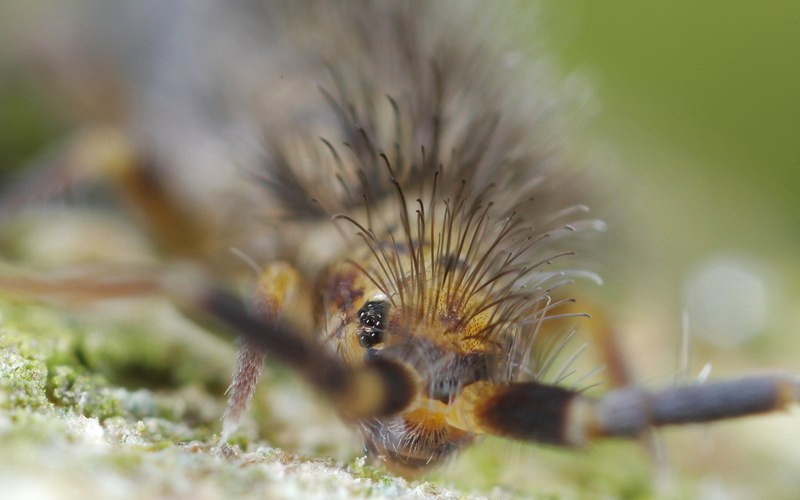
Orchesella villosa
Podura aquatica Linnaeus, 1758
Podura aquatica must be a common species that is strongly bound to water. On stationary waters, it can sometimes appear in large numbers. Longer than one year after I am intensively engaged with springtails, I come to it for the first time in a puddle next to a wet heathland. It's a small springtail, up to 1.5 mm. Note Frans Janssens: With characteristic and distinctly long claws.
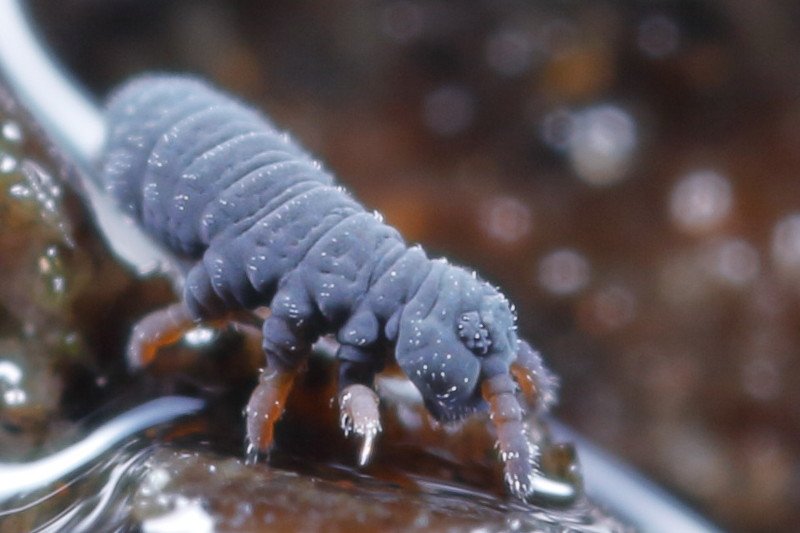
Podura aquatica
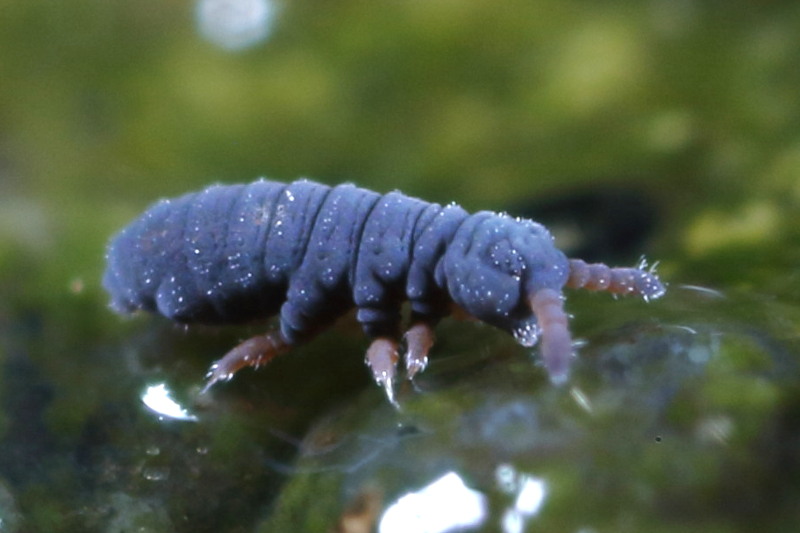
Podura aquatica

Podura aquatica
Brachystomella parvula (Schäffer, 1896)
A very small springtail, until about one mm long. They have a striking color, no spines on the back and on both sides 8 ocelli.

Brachystomella parvula
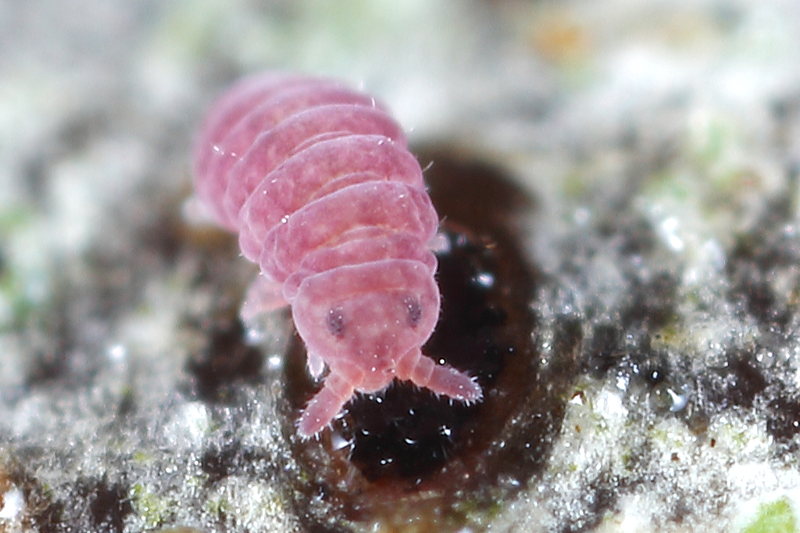
Brachystomella parvula
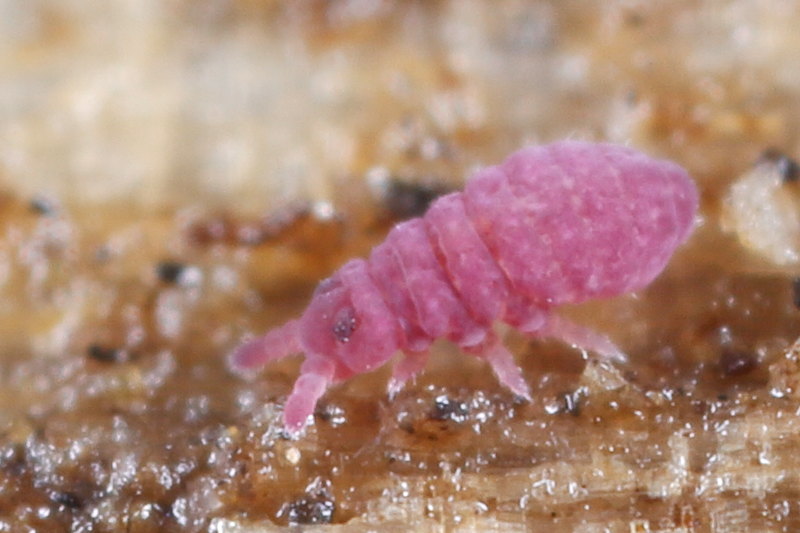
Brachystomella parvula
Ceratophysella bengtssoni (Agren, 1904)
This is a difficult family, there are in the Netherlands some thirty species and the animals are generally very small. That makes it difficult to determine them from a photo. Identify is on the basis of the seta (hair). It is therefore usual to kill the animals and to paste them on a microscope slide. Than the hairs can be viewed with a microscope. Ceratophysella bengtssoni is determined by the very small anal spines, according to Frans in fact almost not visible in this image.
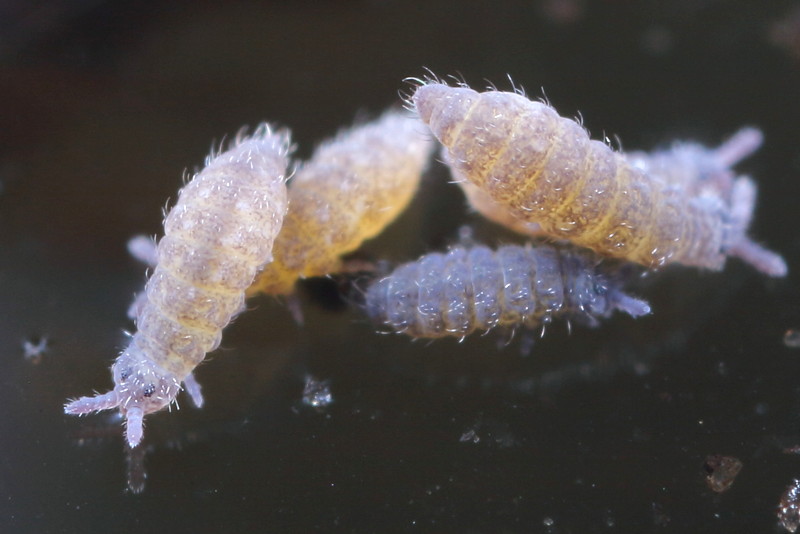
Ceratophysella bengtssoni

Ceratophysella bengtssoni
Ceratophysella denticulata (Bagnall, 1941)
On Ceratophysella denticulata is on the fourth abdomen the middle seta p1 shorter than the next standing p2.

Ceratophysella denticulata

Ceratophysella denticulata
Ceratophysella gibbosa (Bagnall, 1940)
Ceratophysella gibbosa I have found and photographed during an excursion with Matty Berg on 14-03-2014 . The animal is by Matty collected and determined. In a forest near Zaandam is a dead tree on the ground, if I pull a piece of bark from the decaying stem, I find there the animal that stands out for its light color. The first sighting in The Netherlands.

Ceratophysella gibbosa

Ceratophysella gibbosa
Hypogastrura burkilli (Axelson, 1907)
Hypogastrura burkilli is a species that in the Netherlands is known only from the area near Nijmegen. I've found them on the Bank of the river Waal at Nijmegen in the Ooijpolder. The animals are of the size of a Neanura muscorum, so fairly large.
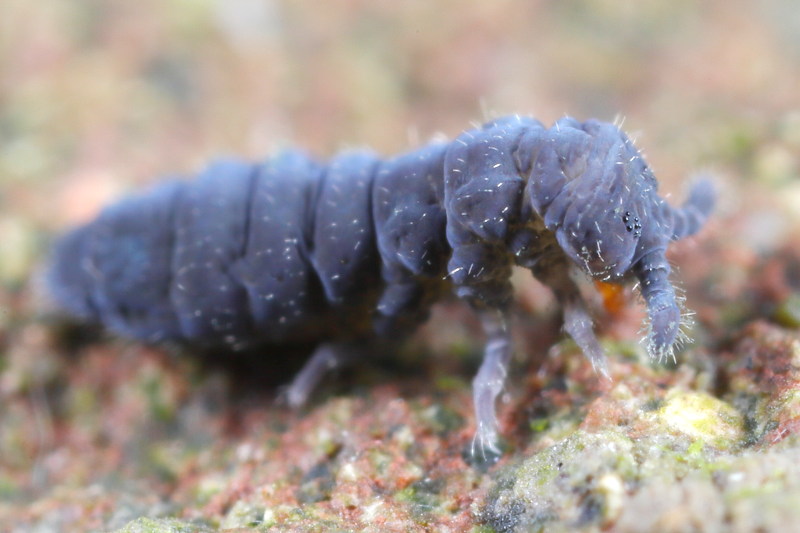
Hypogastrura burkilli
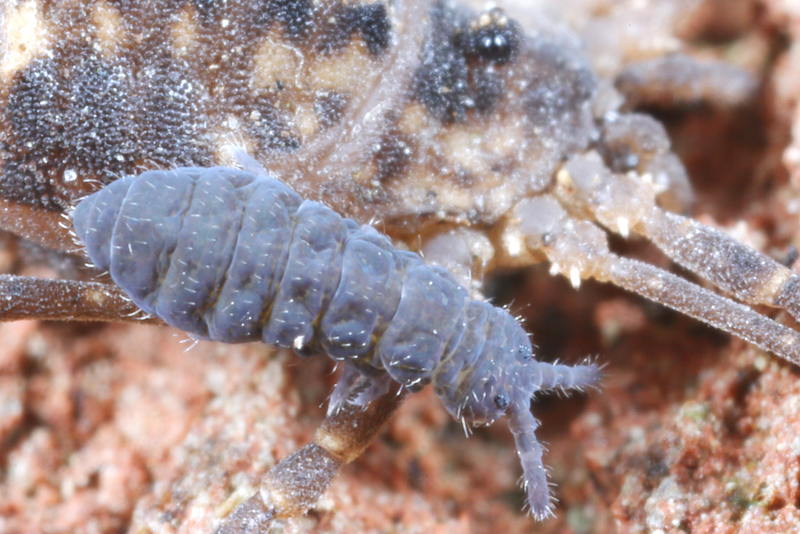
Hypogastrura burkilli
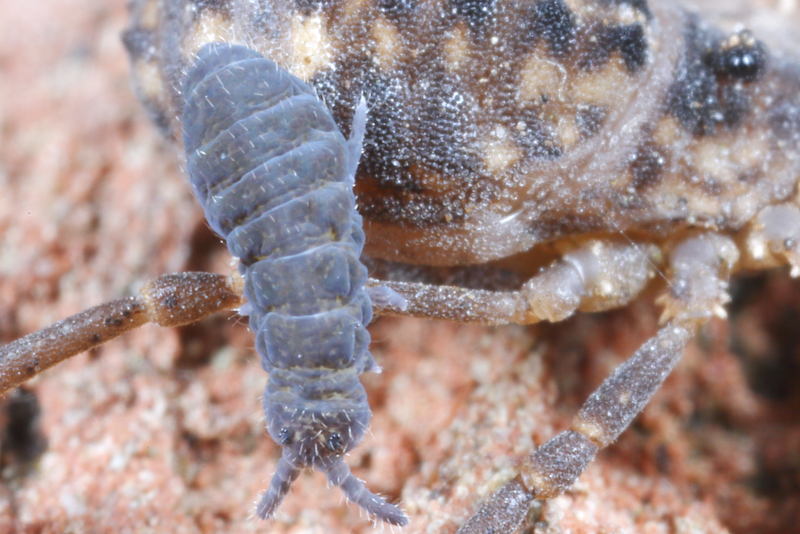
Hypogastrura burkilli
Hypogastrura distincta (Axelson, 1902)
Hypogastrura distincta is a fairly large species about 1.5 mm and got right my attention. I had the impression that I had not seen the species before. So some photos sent to Frans Janssens and yes it turns out to be The first sighting in The Netherlands. 25-10-2018 To be able to see it Frans needed more data, on the first photos were insufficient identification characteristics. Therefore one more time to the same place to make more pictures. Then I succeed to get the legs well on the photograph so that the hairs of the foot can be seen.
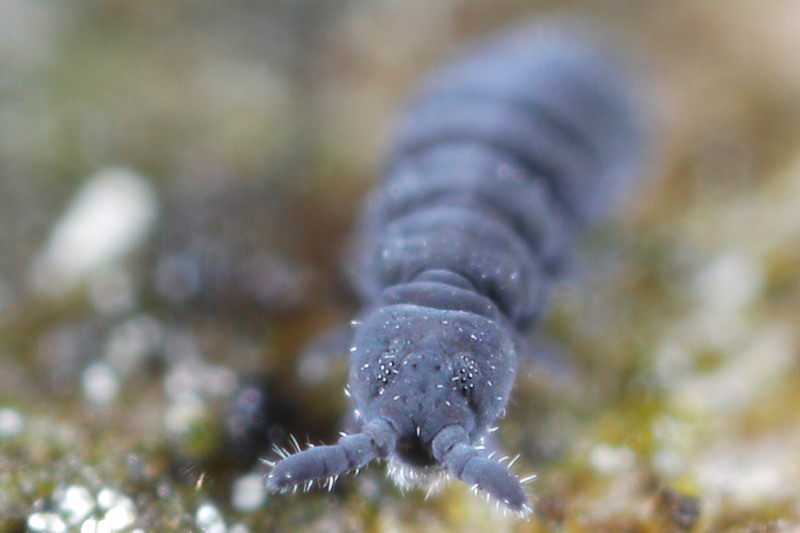
Hypogastrura distincta
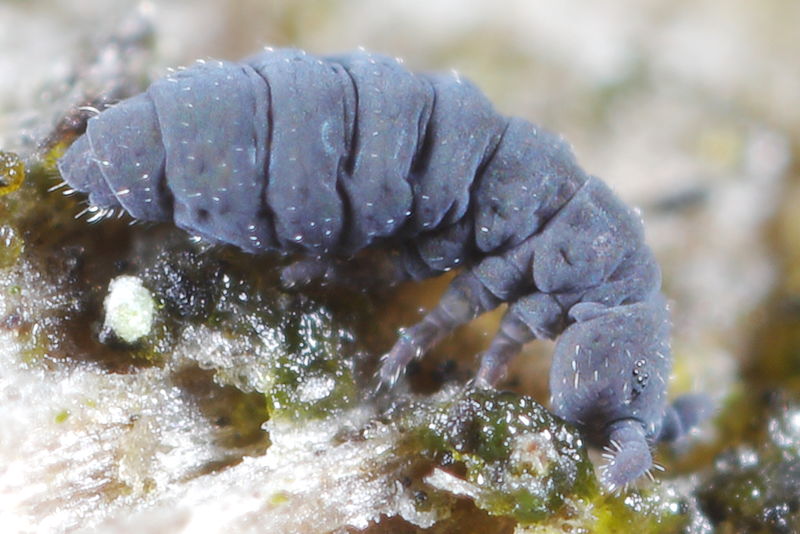
Hypogastrura distincta
Hypogastrura viatica (Tullberg, 1872)
When visiting the Frisian coast at Moddergat, huge numbers of springtails are found up on the washed up seaweed. They are very agile and jump much. A few days later, Matty Berg in the same place also found the animals and collected some for identification. It turns out to be Hypogastrura viatica a very general species.
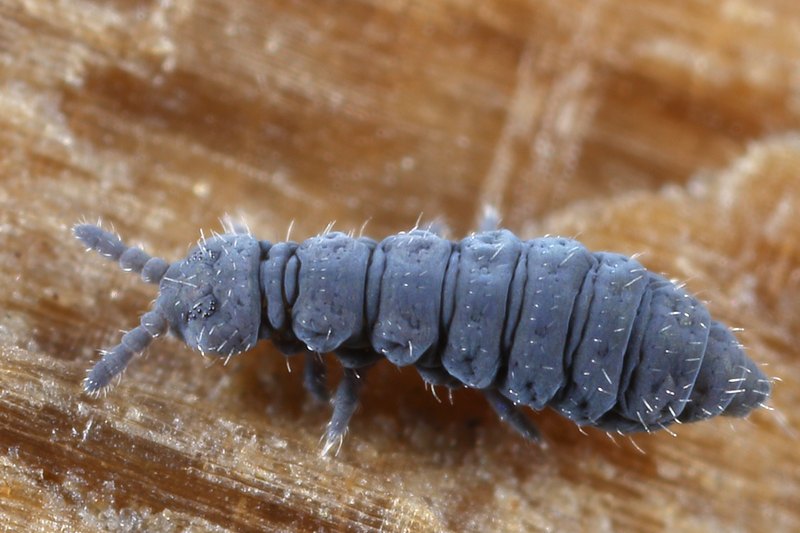
Hypogastrura viatica
Schaefferia sp.
Behind the bark of the chestnut tree next to our House I discover a very small springtail. According to me it is a juvenile Neanura muscorum and so I put it on Flickr.com. Frans thinks it is Schaefferia sp., given the 2 ‘large’ anal spines and the ocelli count is less than 8.
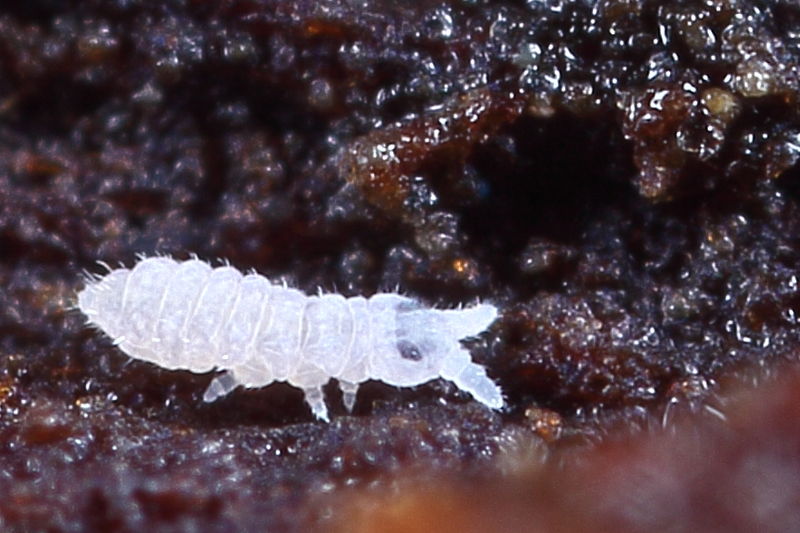
Schaefferia sp.
Xenylla grisea Axelson, 1900
Xenylla grisea is a very small springtail that I've found in my garden on a piece of mossy oak branch. One of the features of this species is that they have but five ocelli. Further characteristics of this species are hard to see on a photo. This photo is identified by Frans Janssens.
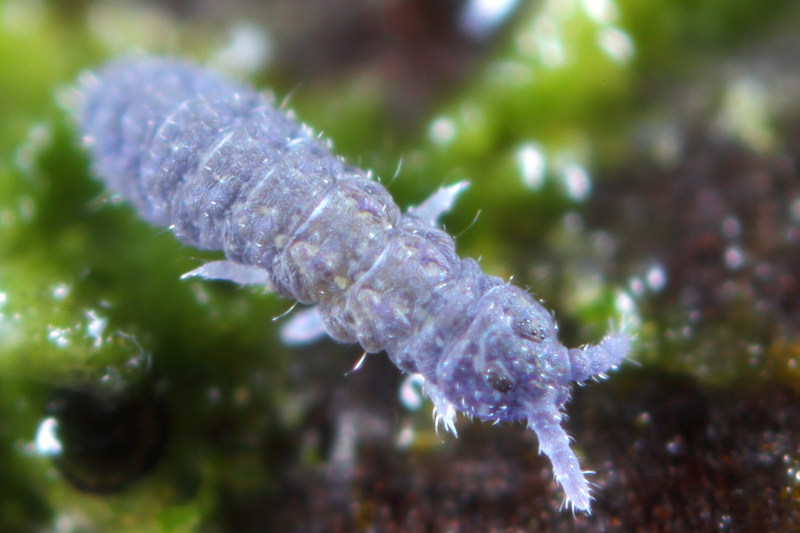
Xenylla grisea
Xenylla maritima Tullberg, 1869
Xenylla maritima is especially found behind the bark of the plane tree. Sometimes you can find them there in large numbers. It's a small springtail and I find it difficult to distinguish it from other small blue grey species. That is also the reason that I only look better to them now. I think I am able to recognize reasonable other types of springtails. Characteristic for this species are the five ocelli.
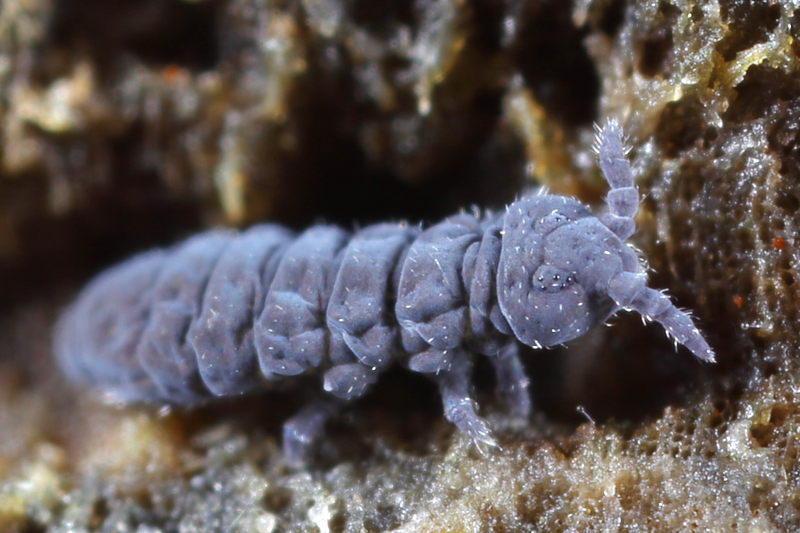
Xenylla maritima
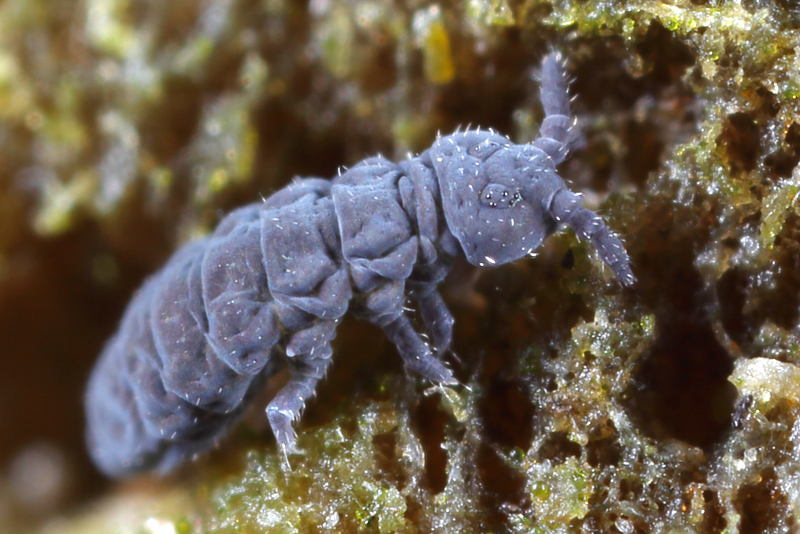
Xenylla maritima
Anurida granaria (Nicolet, 1847)
In a park near Zaandijk where maintenance is quite natural, there walk among others cattle, we find a very nice white springtail that reminds me to Neanura muscorum. Matty who has found the animal knows it's another species Anurida granaria. As well as at other white species is shooting tricky, on the dark background your exposure system of the camera get confused. You have to manually compensate otherwise you get no drawing on the animals.
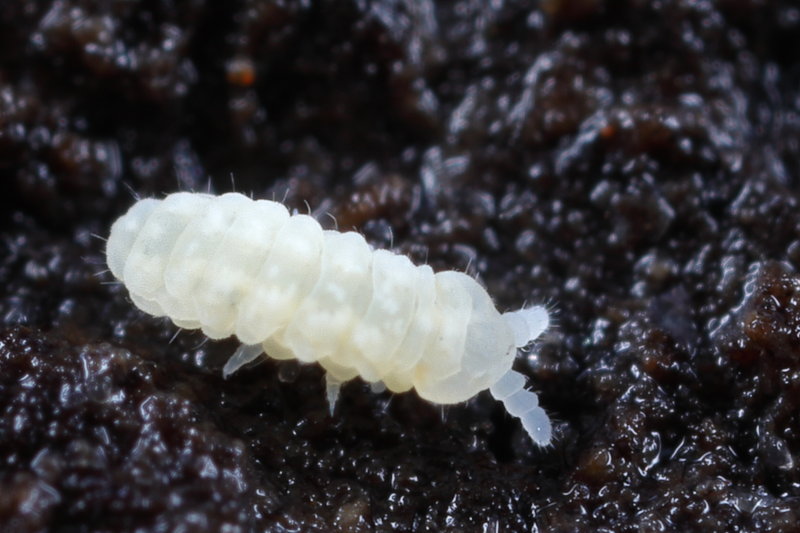
Anurida granaria
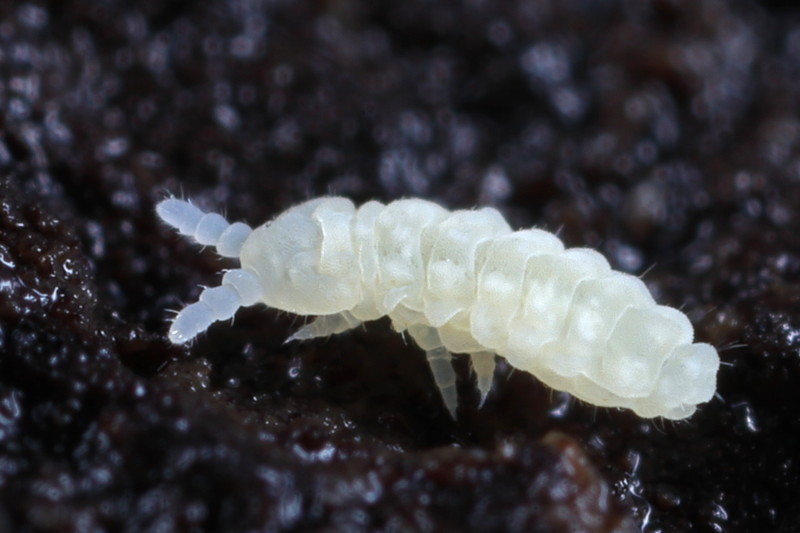
Anurida granaria
Anurida maritima (Guérin-Méneville, 1836)
A common springtail of coastal areas, hence the English name: Seashore Springtail. They can be found under stones and also on the water's surface. You can compare it to Podura aquatica of the fresh water. Sometimes they are found also in large numbers. Both eyes consist of five ocelli. The animals can reach more than 3 mm. A springtail is missing (see photo of the bottom), so it can't jump.
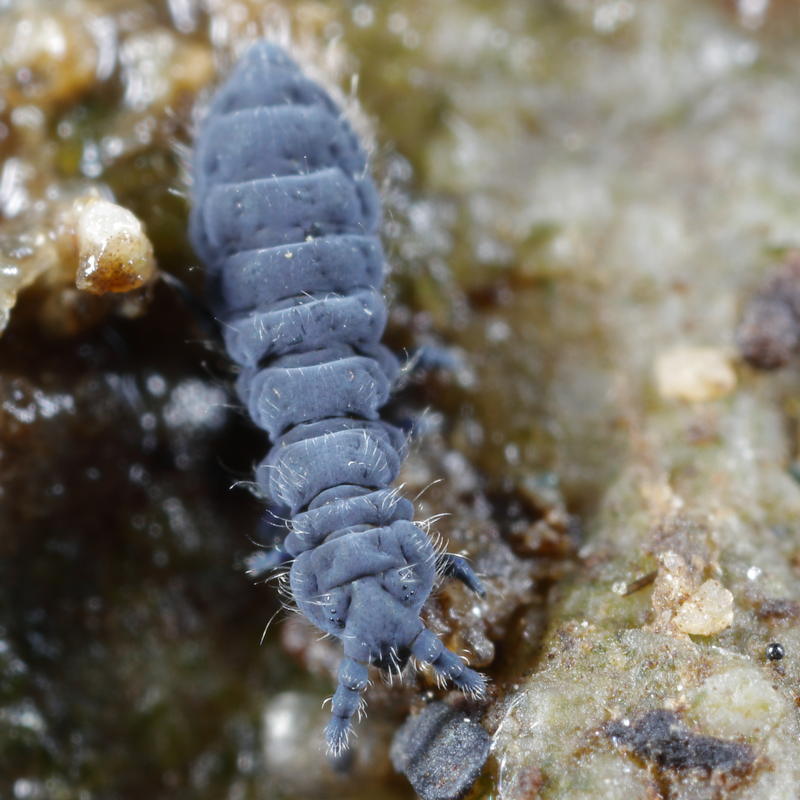
Anurida maritima
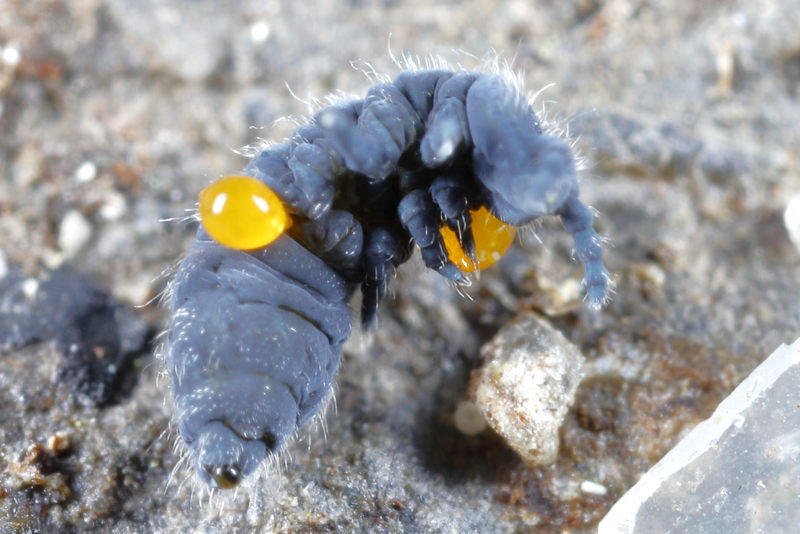
Anurida maritima
Bilobella braunerae (Deharveng, 1981)
Bright orange in color is Bilobella braunerae. This species was first described for The Netherlands in 2009. At the bottom of this page is a link where you can download this description (Berg, 2009 bilobella and neanura) (in Dutch). It is a rare animal, known from three places in The Netherlands. You can find it under old tree bark and trunks on very damp places. The photos were taken in Zaandijk at the place where it was first found in The Netherlands, with thanks to Matty Berg.

Bilobella braunerae
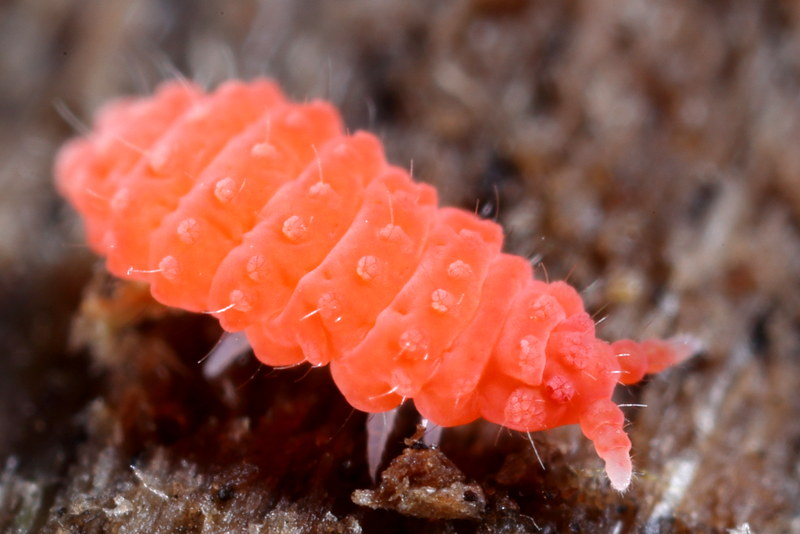
Bilobella braunerae
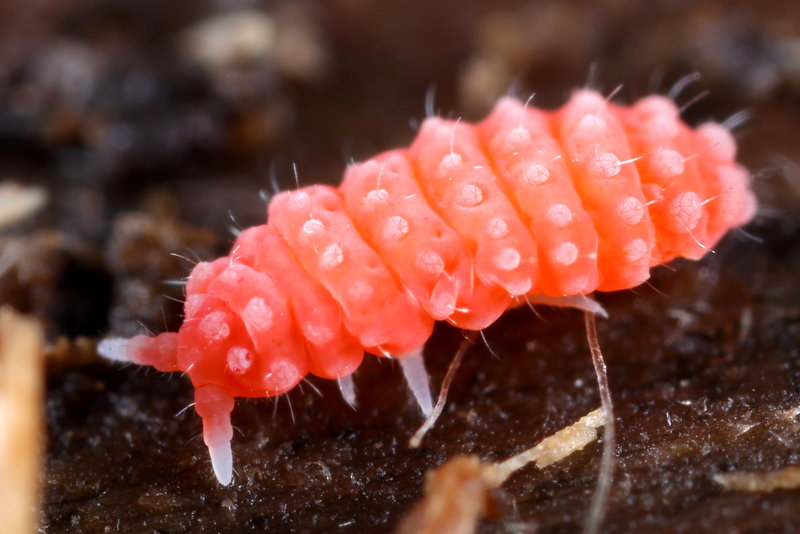
Bilobella braunerae
Monobella grassei (Denis, 1923)
Monobella grassei is first found in The Netherlands by Anne Krediet on 2016-01-16 in Zuid-Limburg. After a number of unsuccessful attempts to find and photograph the animal, I now succeeded to take photos, thanks to Anne Krediet. The animal is under wet branches or leaves and also in very rotten wet wood. If you reverse a leaf where there is one below you see that instantaneously, it is a fairly large animal with a very light color, yellow or almost white when they are younger.
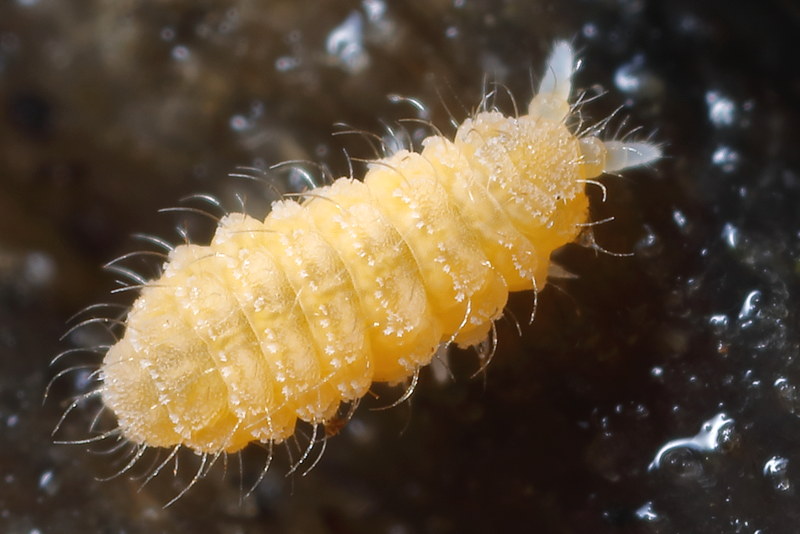
Monobella grassei
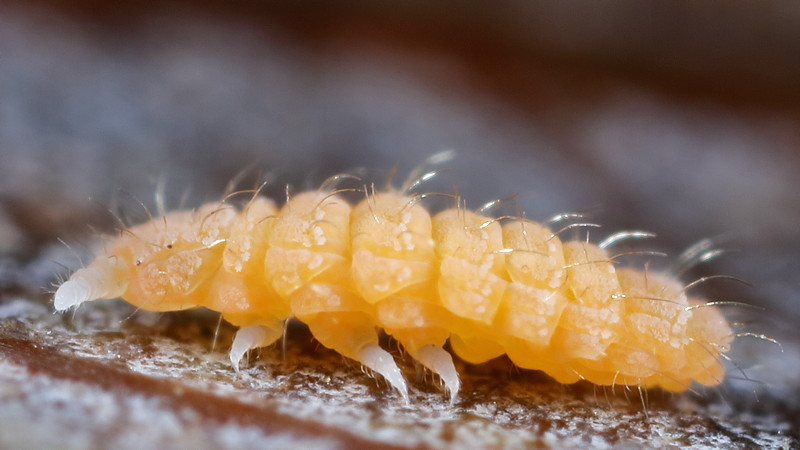
Monobella grassei
Neanura muscorum (Templeton, 1835)
These animals are not in the possession of a springtail and usually run pretty slow. They are also easy photo models, also because they are quite large, up to 3 mm. You will find them mainly under dead wood. A good characteristic are the long yellowish spiny hairs and the two bumps on the back of the body.

Neanura muscorum
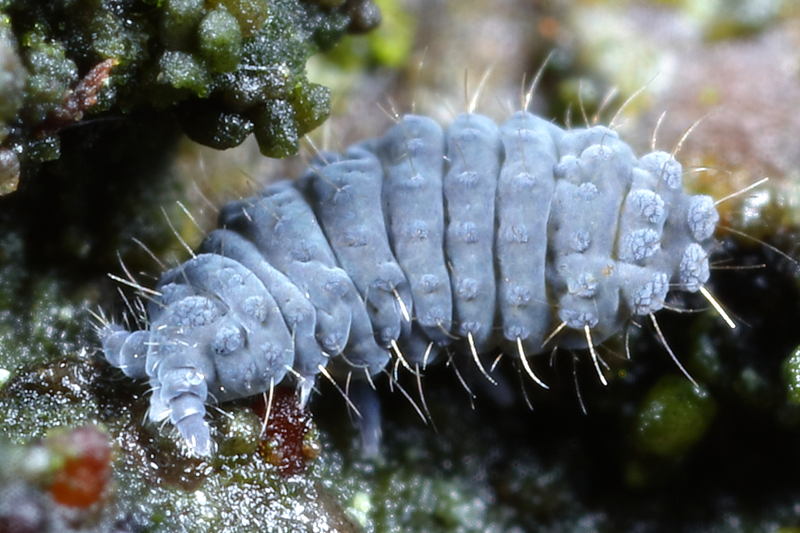
Neanura muscorum
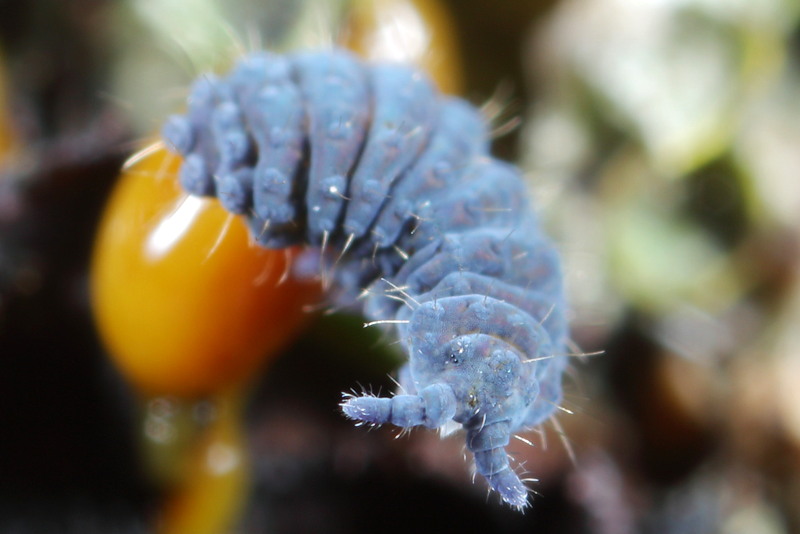
Neanura muscorum
Pseudachorutes spec.
It is impossible to determinate these Pseudachorutes sp. to the species from a picture. In The Netherlands there are four species that all are rare. It's a solid animal and quite big about 2 mm. It does not move quickly and I can make a series of pictures from it. A day later when I go check out the Heath at Schoonloo, it is still under the same branch. I have the impression that it is feeding on a Slime mold.

Pseudachorutes sp.
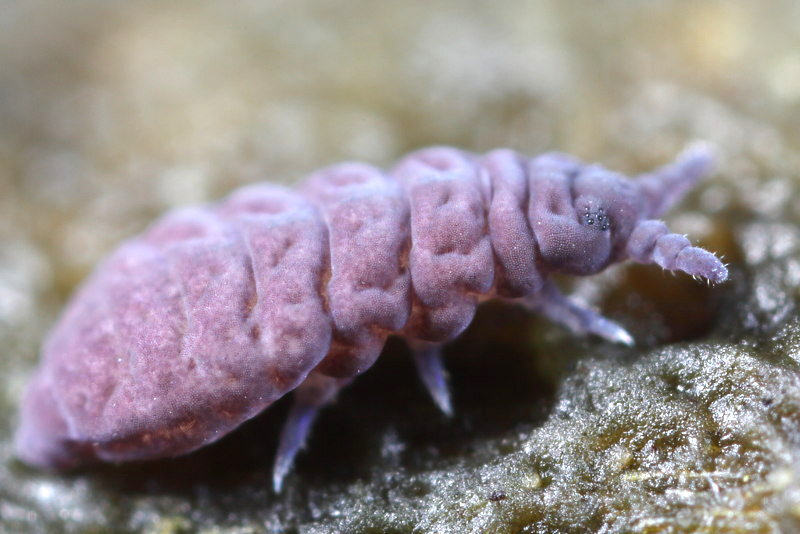
Pseudachorutes sp.
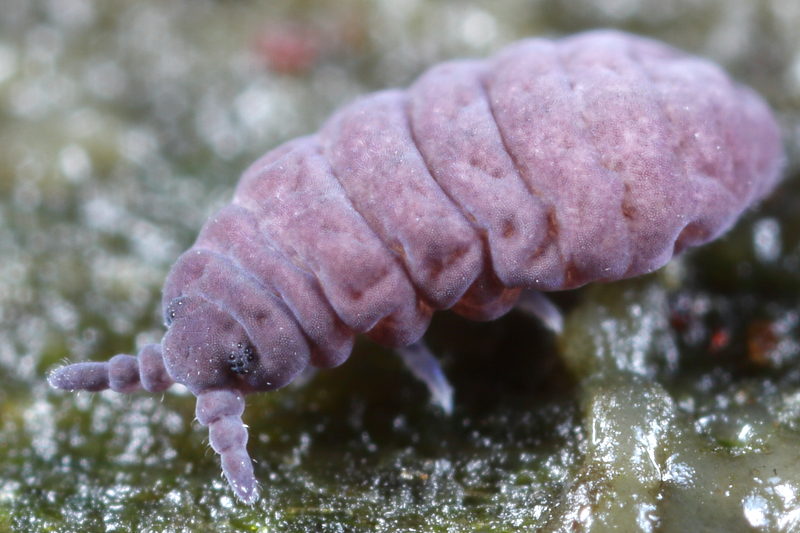
Pseudachorutes sp.
Onychiurus edinensis (Bagnall, 1935)
In Zaandam in a pile of decayed branches Matty Berg finds a Onychiurus edinensis. Of all the pictures that I make there is only 1 a bit sharp. It is a small animal without eyes.

Onychiurus edinensis
Protaphorura armata (Tullberg, 1869)
Turning a pretty big block in a moorland I see some white springtails walking around and within minutes disappear in the ground. On the stone there is another one that also runs around but cannot hide. Making me a lot of trouble to take a reasonable sharp picture from it. It is a soil springtail Protaphorura armata it can't jump and has no eyes, a very common species.
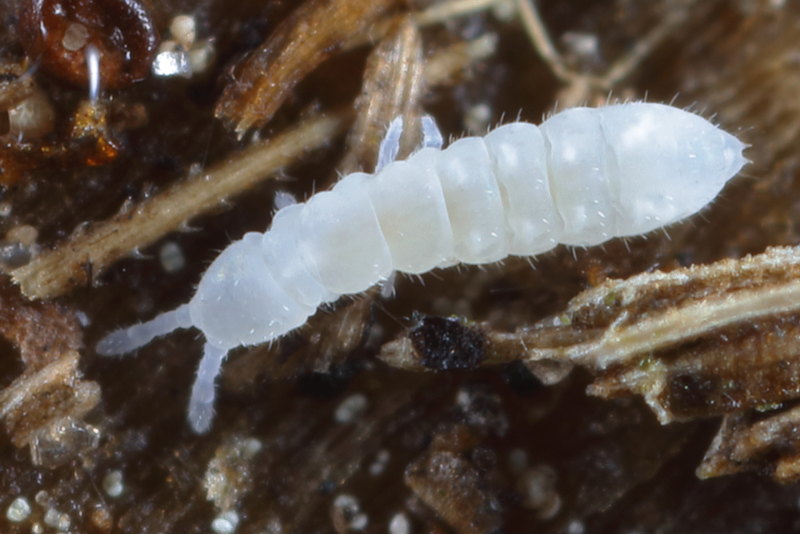
Protaphorura armata
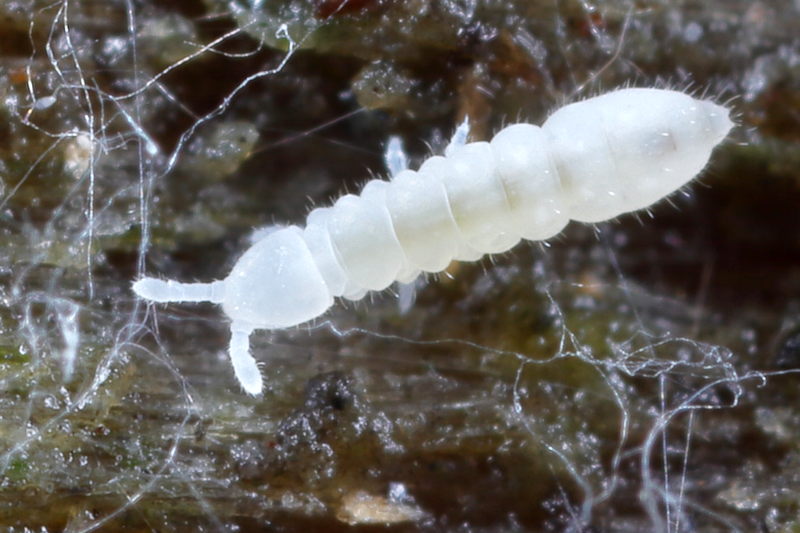
Protaphorura armata
Paratullbergia callipygos (Börner, 1902)
Again a very small, white and fast moving springtail. A whole group of these animals is under a branch on the Moor near Schoonloo. There is a large number and thereby I get several animals in the pictures. This allows me to take out of the different pictures those ones that are on the last segments very sharp. The species characteristics sit on segment nr 6, 2 anal spines posteriorly and 2 curved ridges anteriorly.

Paratullbergia callipygos
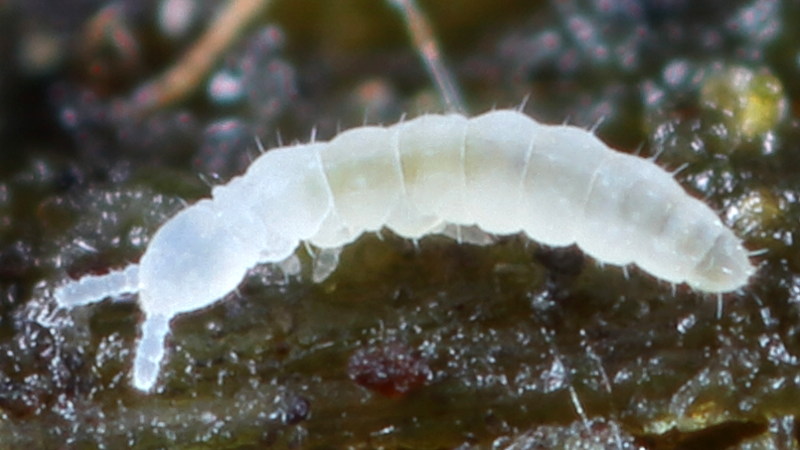
Paratullbergia callipygos
Cyphoderus albinus Nicolet, 1847
27-03-2011 This afternoon I turn around a garden tile and under it are ordinary street ants. When most ants are walked away, I see a small all white springtail. It is very small and moves like the ants walk. Run a half inch, then one tenth of a second stop, than in a different direction a half inch, stop, etc. It's terrible, you think you have it in focus, it just starts running again. This type of spring tail is completely blind, has no eyes, they live in ants nests.
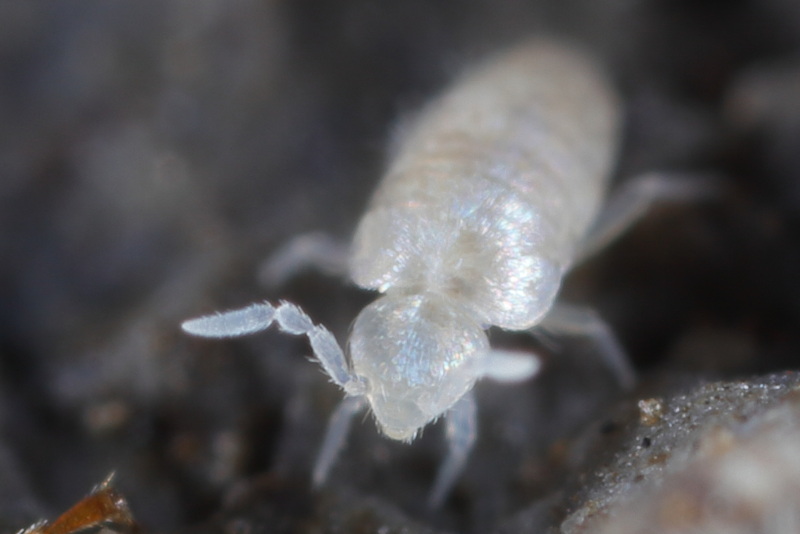
Cyphoderus albinus
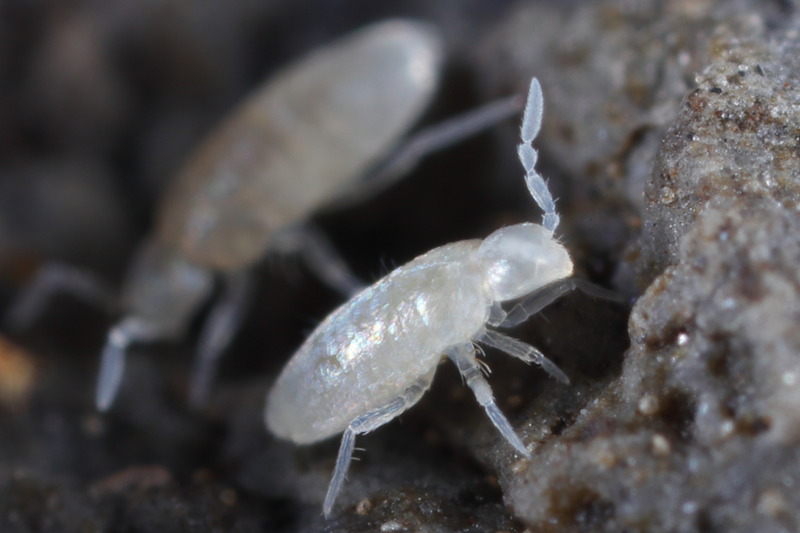
Cyphoderus albinus
Anurophorus laricis Nicolet, 1842
This spring tail is not in the possession of a springtail. It is able to survive extreme drought and extreme cold in the normal winter period. Outside the normal cold season, the animals have no anti-freeze. The color of the small animal, smaller than 2 mm, is metallic gray. This species I found around the Zuidlaardermeer in the province of Groningen, it is a common species. They feed mainly on lichens.

Anurophorus laricis

Anurophorus laricis
Ballistura schoetti (Dalla Torre,1895)
On a stone on the bank of the river Waal I find a large number of springtails that are sitting close together. They look a bit like Podura aquatica, but they clearly are not. They don't jump away when I lift the stone and walk with it what Podura aquatica would have done directly.
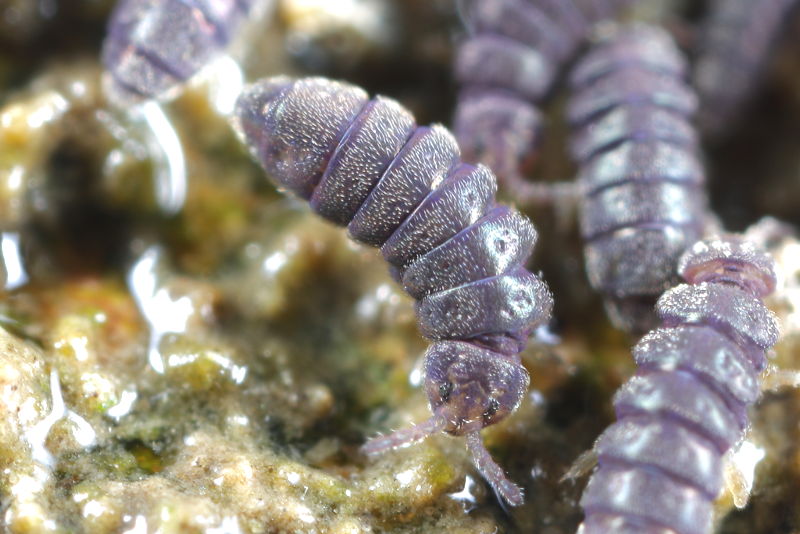
Ballistura schoetti
Cryptopygus thermophilus (Axelson,1900)
26-03-2012.Yet another springtail that becomes its name after a long time. The photo is already made in March 2011, but now I get to know that Frans Janssens has provided it a name, Hemisotoma thermophila, (given the apparently fused abd.5+6 FJ). It is a small springtail.

Cryptopygus thermophilus

Cryptopygus thermophilus

Cryptopygus thermophilus
Folsomia candida Willem, 1902
Folsomia candida is one of the eyeless white species that are difficult to photograph. The body is long and the animals are fast, furthermore you have no eye where you can focus on. Another problem is the bright white on mostly very dark background, this causes on photos often a white cloud around the animal. This animal I have found in the greenhouse in a container where I have sown seeds in. You can recognize them because the last body segments, the Nos. 4, 5 and 6 are fused together. (Thanks to Frans Janssens).

Folsomia candida
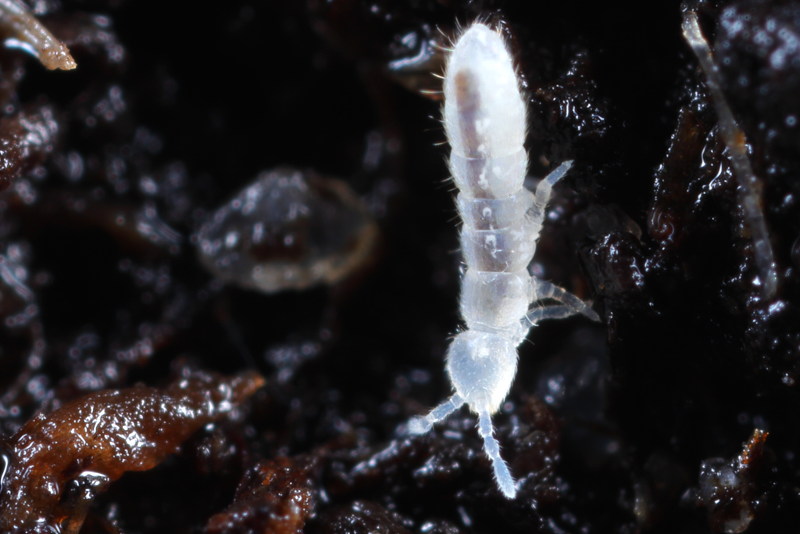
Folsomia candida
Folsomia quadrioculata (Tullberg,1871)
Folsomia quadrioculata has, as the name implies, but four ocelli, two on each side. This species I have found on a piece of moorland near Schoonloo, that is grazed by sheep.
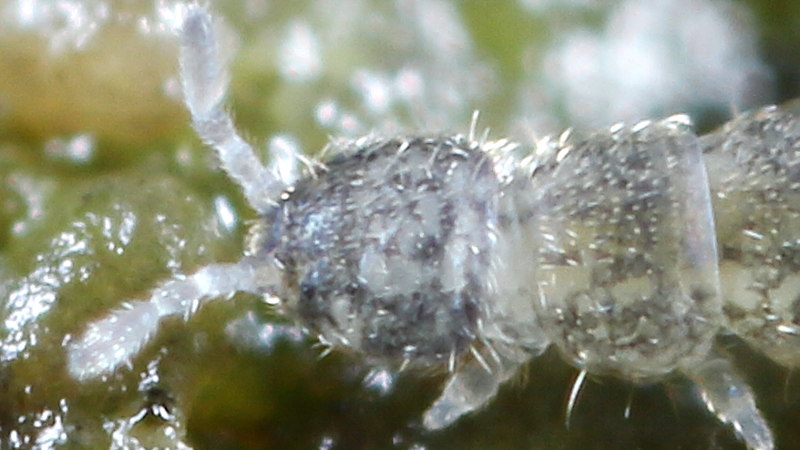
Folsomia quadrioculata
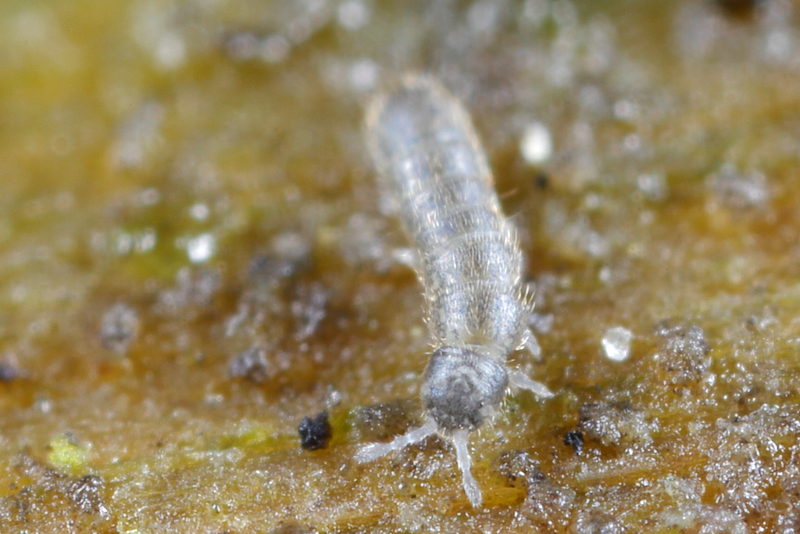
Folsomia quadrioculata
Paychyotoma crassicauda (Tullberg, 1871)
Paychyotoma crassicauda I found together with Podura aquatica on a piece of floating bark in a rainwater puddle next to a piece of wet heathland near Schoonloo (Drenthe). The first sighting in The Netherlands on 28-07-2011.

Paychyotoma crassicauda
Desoria olivacea (Tullberg, 1871)
The family Desoria I find difficult to differentiate from the family Isotomurus. They are quite similar and there are many species. The setae (long hairs) are also here the difference. At Desoria those are short on the back and long at Isotomurus. I especially find this species on the surface of the pond and if there are somewhere rainwater puddles.
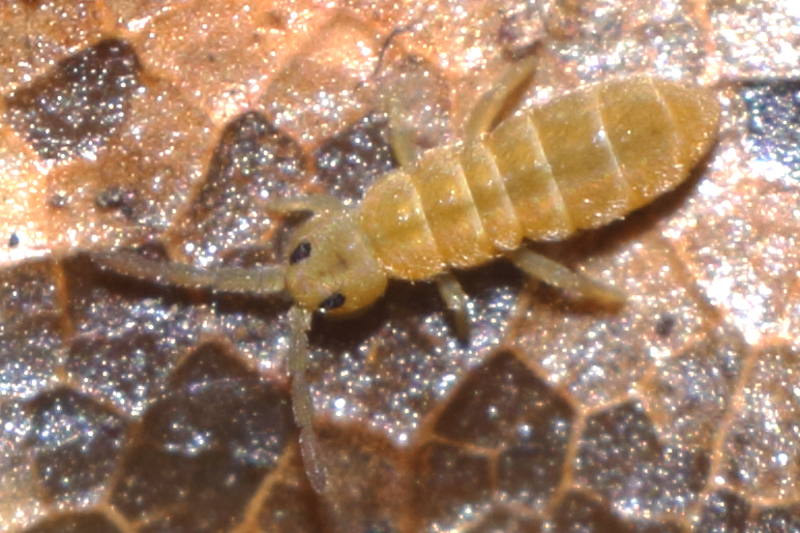
Desoria olivacea
Desoria tigrina Nicolet, H. 1842
Desoria has also relatively short setae (long hair) on the abdomen, the characteristic of the Desoria group.

Desoria tigrina
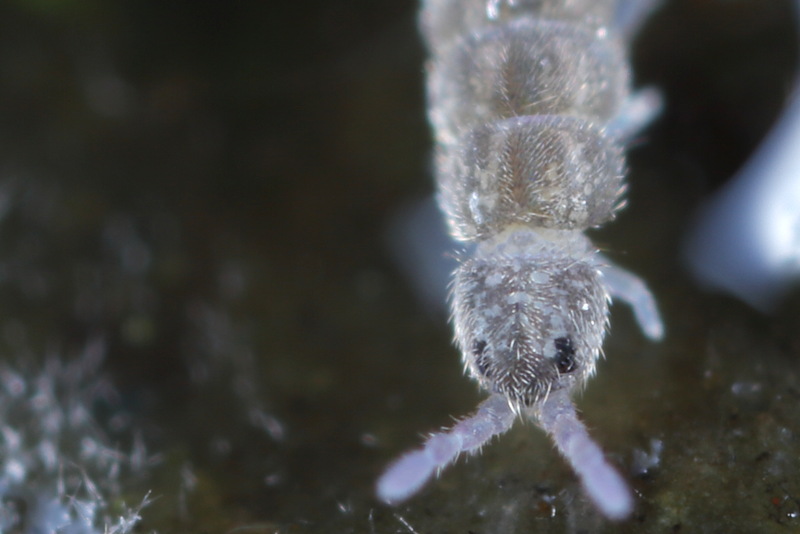
Desoria tigrina

Desoria tigrina
Desoria trispinata (Mac Gillivray, 1896)
When schooting an other springtail on the side of my pond, there walk all of a sudden blue springtails along. They are fast and I succeed to make some reasonable photos. Probably it's Desoria trispinata according to Frans Janssens. Afther several nights of frost there are dead specimens on the water, apparently they can't stand this.
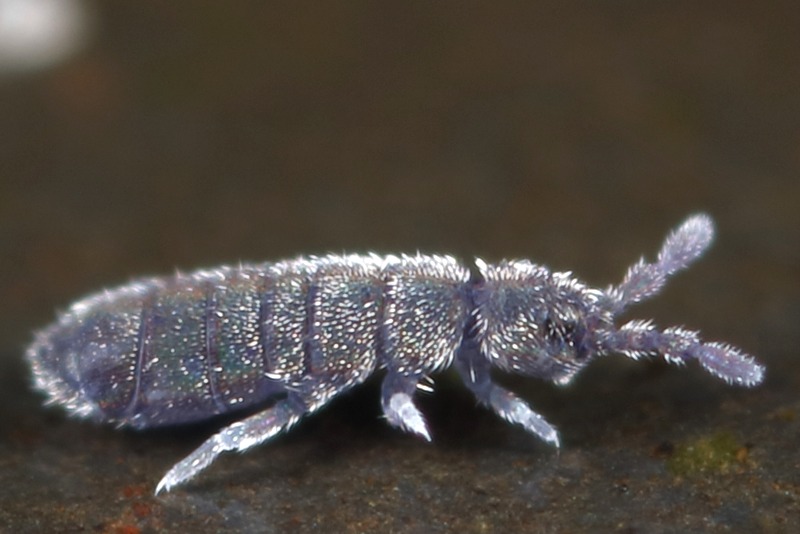
Desoria trispinata

Desoria trispinata
Isotoma anglicana Lubbock, 1873
Isotoma anglicana can be found on the impregnated wood of the wind shield next to the house. On very dry dead wood in a heathland site I have found him otherwise. By the drawing on the skin you can set it apart from Isotoma viridis
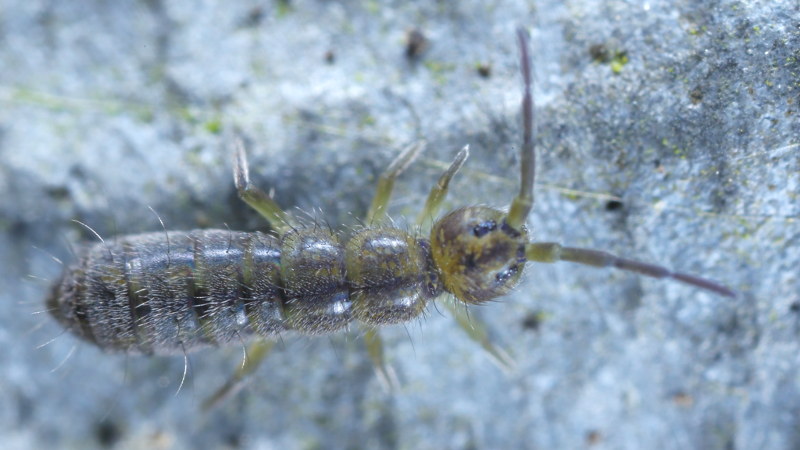
Isotoma anglicana
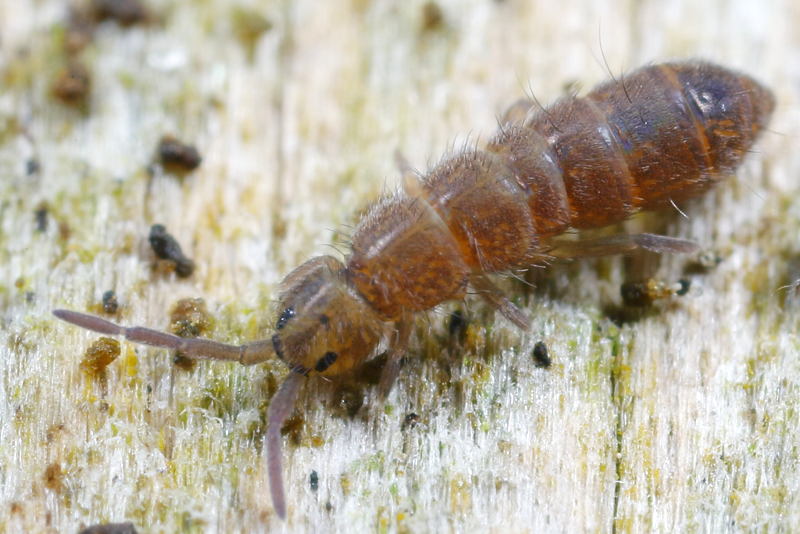
Isotoma anglicana
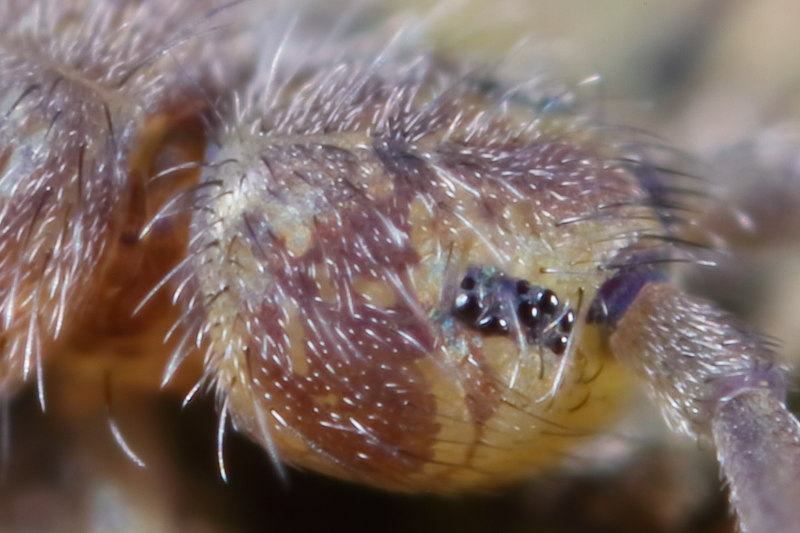
Isotoma anglicana
Isotoma caerulea (Bourlet, 1839)
Isotoma caerulea is difficult to distinguish from Isotoma anglicana, "caerulea" means blue and you would therefore say that the animal on the picture meets. Unfortunately, of all Isotoma's is only Isotoma riparia sure to bring on name from a photo. The others are only to determine on the basis of the hairs on the spring mechanism.
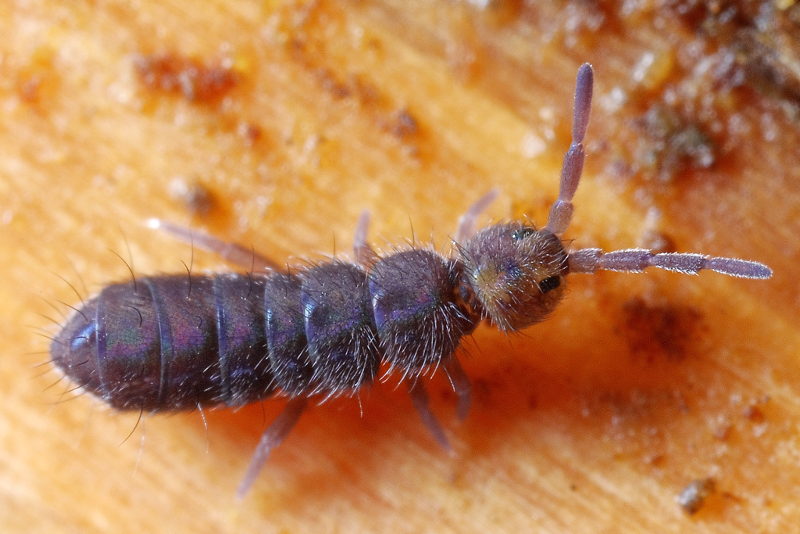
Isotoma caerulea
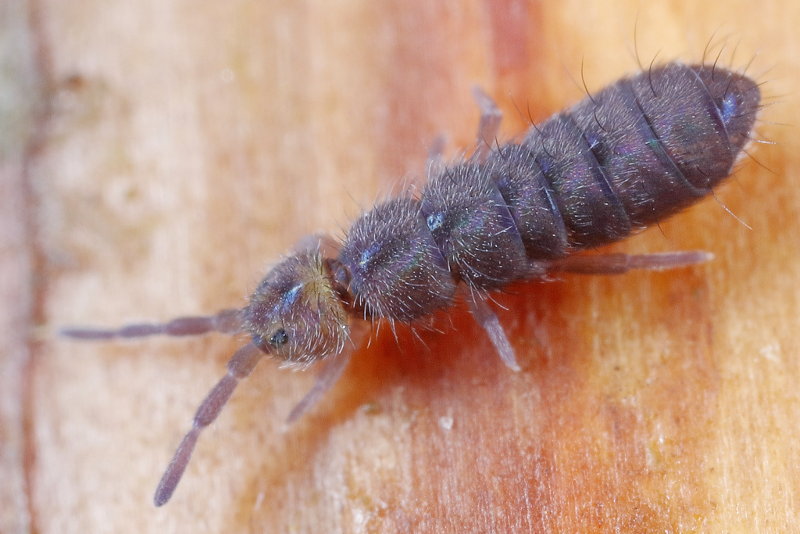
Isotoma caerulea
Isotoma riparia (Nicolet, 1842)
Regularly I spend a day in nature with Peter Wieringa to photograph springtails and other nice animals. That is also the case when I shoot Isotoma riparia. Peter has photographed this species one time close to his house and we go there again because I also like to make some pictures. Unfortunately, this time there is at this place no springtail at all. We drive on to the Dollard and shoot a lot of woodlice, harvestmen and springtails. On the outside of the sea dike is very much plant material with pieces of wood, to very high against the dike. This is a gold mine to find small animals. I also take two pictures of what I think is a Isotomurus palustris, but when I get home and view the pictures on the pc, I see that the animal has macro setae (long hairs) on all body segments, it's a Isotoma riparia.
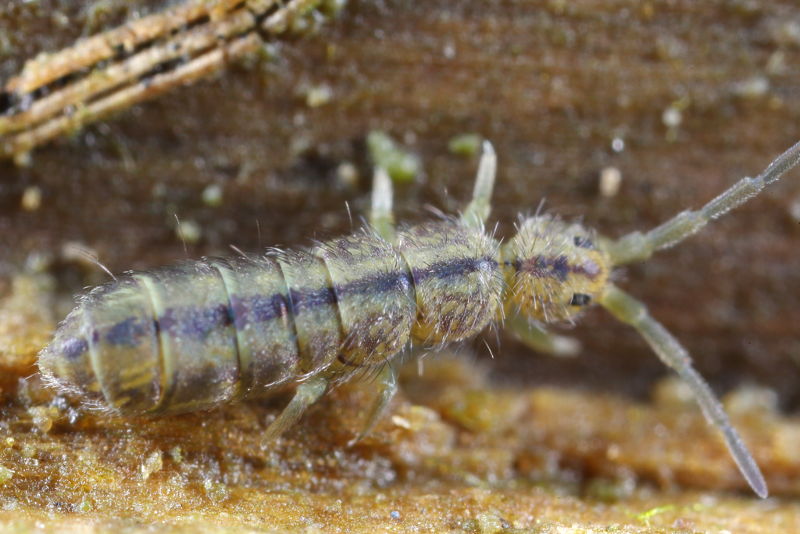
Isotoma riparia
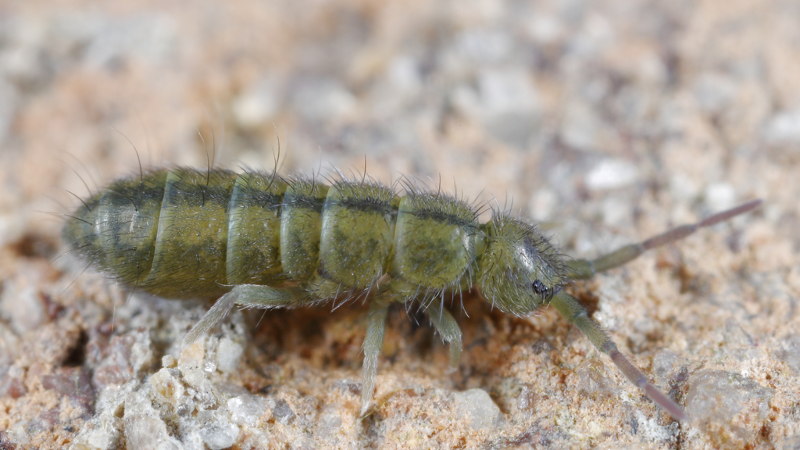
Isotoma riparia
Isotoma viridis Bourlet, 1839
Isotoma viridis I do find much in the garden, often on the swimming pond and also under pieces of dead wet wood in nature reserves. It is an animal of wet areas. So it sits on pieces of firewood that remain on the lawn.
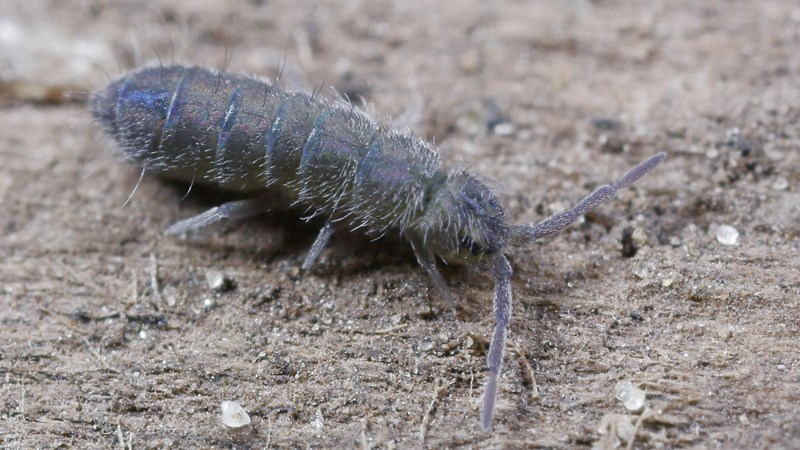
Isotoma viridis
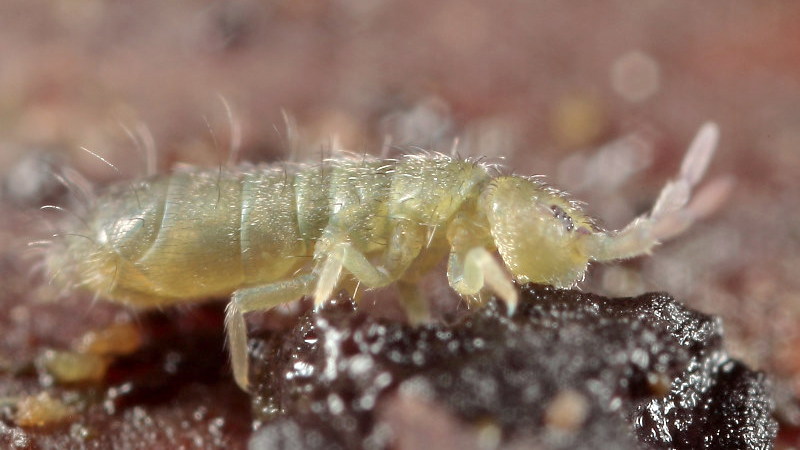
Isotoma viridis
Isotomiella minor (Schäffer, 1896)
A springtail without ocelli and thus a soil animal is Isotomiella minor. It lives in the soil and leaf litter and is fairly common. They are small animals, up to 1.3 mm. They are white in color and slightly translucent allowing you to see a clear back stripe on the pictures. It is the intestine, its color may vary depending on what the animal has eaten, if it did not eat the stripe is absent.

Isotomiella minor
Isotomurus gallicus Carapelli, Frati, Fanciulli & Dallai, 2001
Isotomurus gallicus is 27-01-2016 first found in The Netherlands by Louis Geraets.
The site is located in Noord Brabant in Offelt next to a railway. The same railway line also runs along Molenhoek, a place where
I photographed another rare springtail. Because it is close by, I go there also to search and there I find it too, the second place.
It are very small animals just about 2 millimeters. They sit under the stones that are used at the track and also further from
the track in the moss. In Molenhoek they are also under pieces of dead wood.
This springtail has the hairs as with Desoria, on other characteristics it is assigned to
Isotomurus, by Fauna Europaea and Dr. Arne Fjellberg a specialist in Collembola.

Isotomurus gallicus
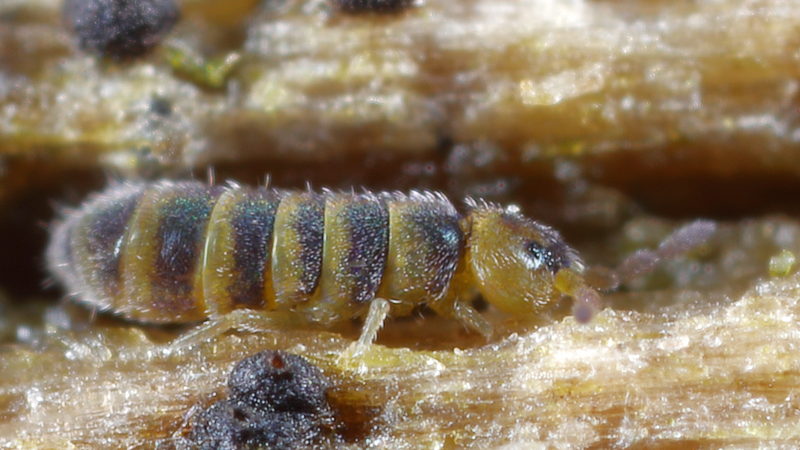
Isotomurus gallicus
Isotomurus graminis Fjellberg, 2007
Isotomurus graminis is a recently described species, before it was called Isotomurus prasinus, but new insights indicate that this species occurs in Eastern Europe. Isotomurus graminis can easily be confused with Isotoma viridis, both are greenish oblong animals, the difference are the setae (long hairs), with Isotoma on all body segments macro setae, at Isotomurus only on the rear segments.
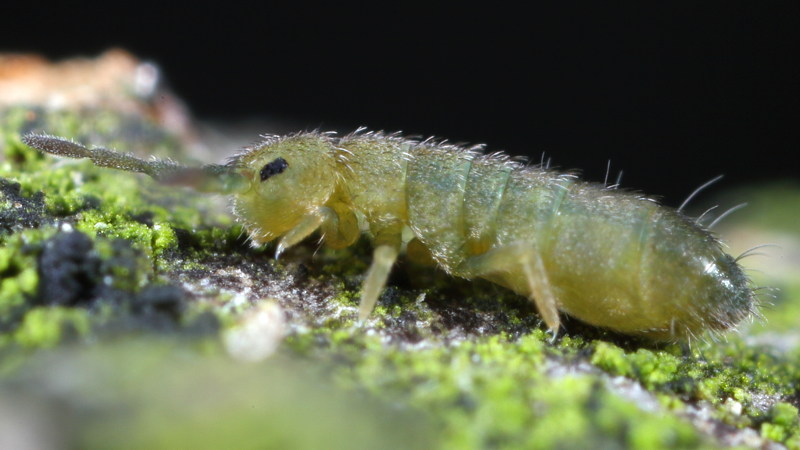
Isotomurus graminis

Isotomurus graminis
Isotomurus maculatus (Schäffer, 1896)
A springtail that looks much similiar to Isotomurus palustris is Isotomurus maculatus. You can recognize it by the line in the middle over the body, this is not a solid line but a collection of spots, seen from the head the spots look like a crown. The first sighting of the species in The Netherlands is described in 2001, Matty Berg, et al.(2001). This article (pdf) you can download from the Naturalis website, sorry it is in Duch language.

Isotomurus maculatus
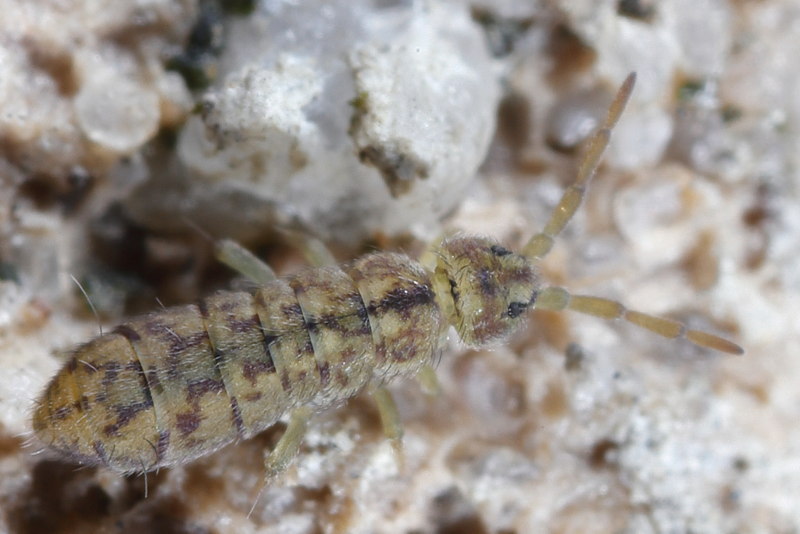
Isotomurus maculatus
Isotomurus palustris (Müller, 1776)
This species was formerly not distinguished from Isotomurus pseudopalustris, all older observations are of this species. Nowadays Isotomurus palustris is the animal in which the back stripe goes not through to the end of the abdomen and where there are shadow stripes present. If the line runs through and there are shadow stripes than Isotomurus pseudopalustris, at a continuous stripe without shadow stripes it is Isotomurus unifasciatus.
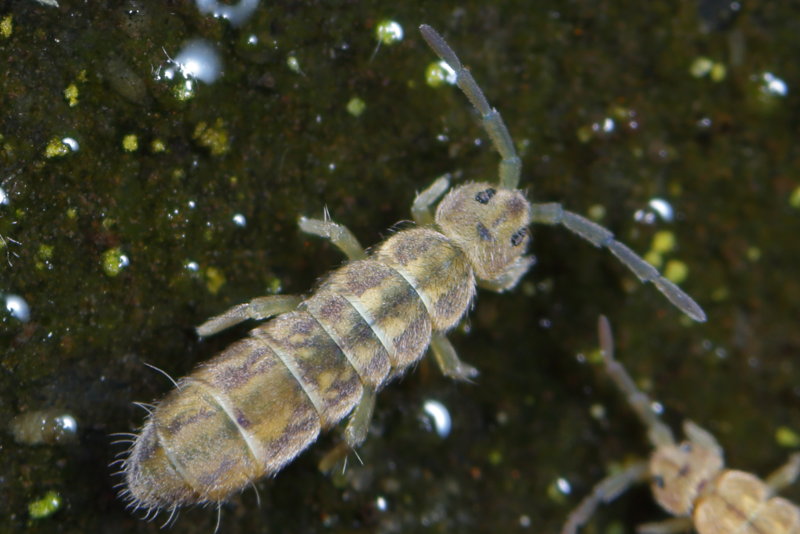
Isotomurus palustris

Isotomurus palustris

Isotomurus palustris
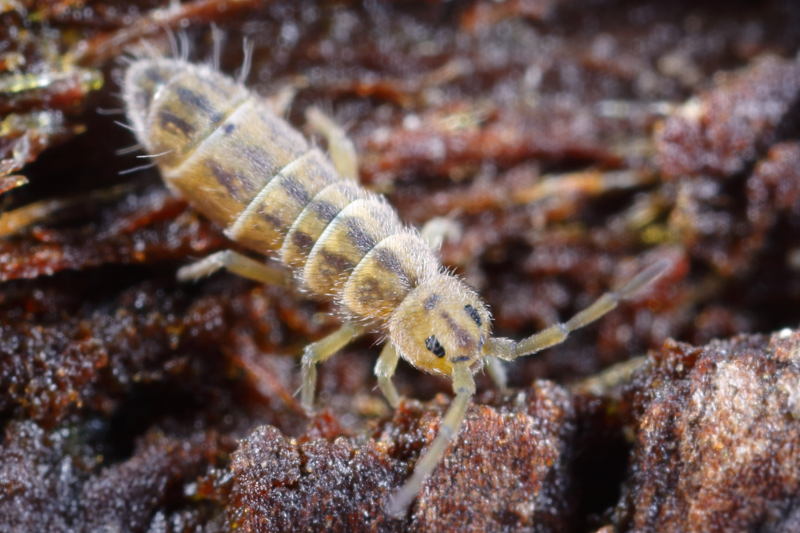
Isotomurus palustris
Isotomurus plumosus Bagnall, 1940
In a dry Brook I find Isotomurus plumosus under a very humid branch. My first find here is a juvenile and I decide to go there a few more times to find a mature one. This species has a broad dark band across thorax and abdomen and also on the ventral side. After searching a few times, finally an adult specimen. Some other species that occur in the dry Brook are: Isotomurus palustris, Pogonognathellus flavescens, Heteromurus major and Dicyrtomina minuta.

Isotomurus plumosus

Isotomurus plumosus, juvenile
Isotomurus pseudopalustris Carapelli, Frati, Fanciulli & Dallai, 2001
Isotomurus pseudopalustris is a species newly described in 2001. The difference with Isotomurus palustris is the continuous middle stripe across the back. Further can the drawing next to the middle stripe vary from barely visible to very dark.
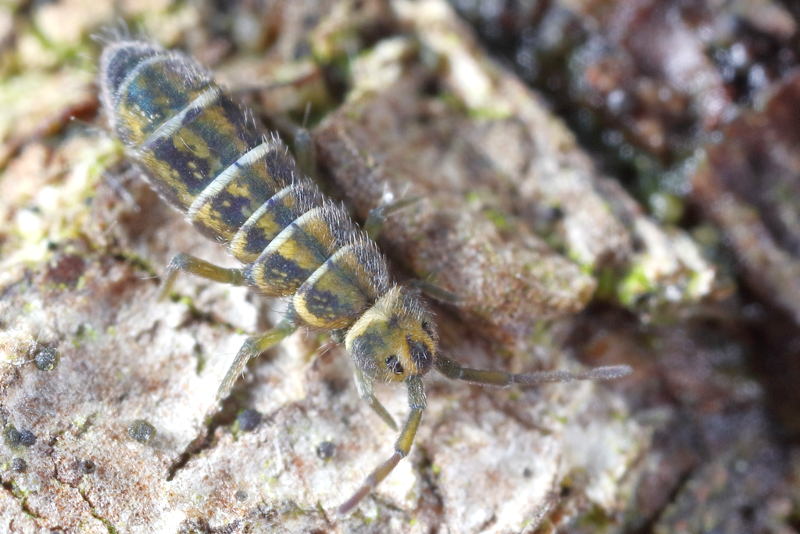
Isotomurus pseudopalustris

Isotomurus pseudopalustris
The stains on the back of the animal below are triangular and the point of the triangle points to the rear. It is a color form with the name: Isotomurus pseudopalustris f. gervaisi.
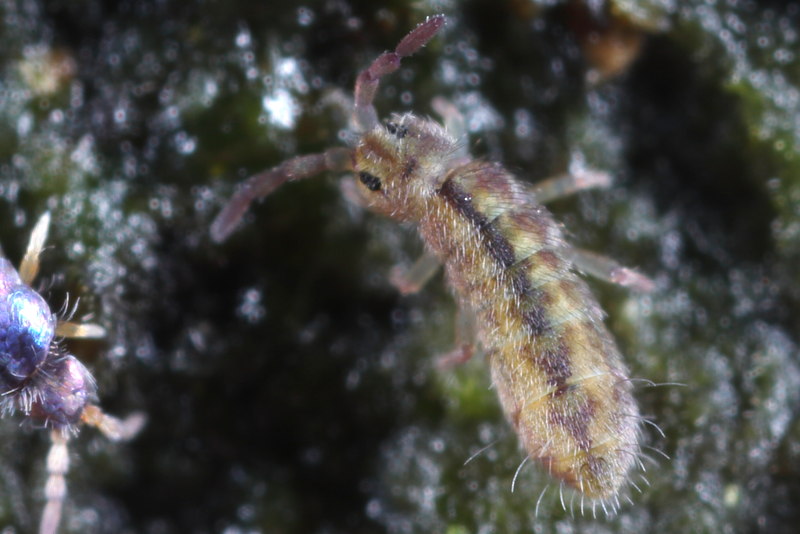
Isotomurus pseudopalustris f. gervaisi
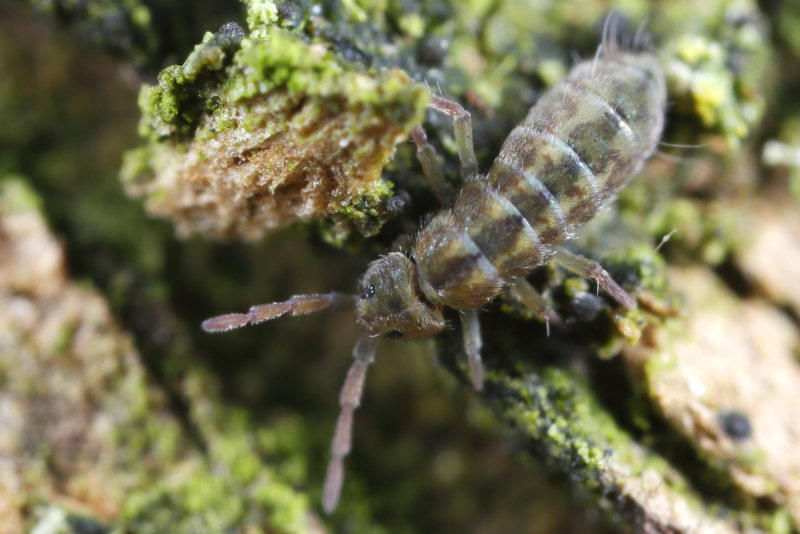
Isotomurus pseudopalustris f. gervaisi
Parisotoma notabilis (Schäffer, 1896)
A small springtail, grey and with a square looking eys is determined by Matty Berg on waarneming.nl as Parisotoma notabilis. These animals are so small and have to my idea no really striking features, so I don't just recognize them yet.
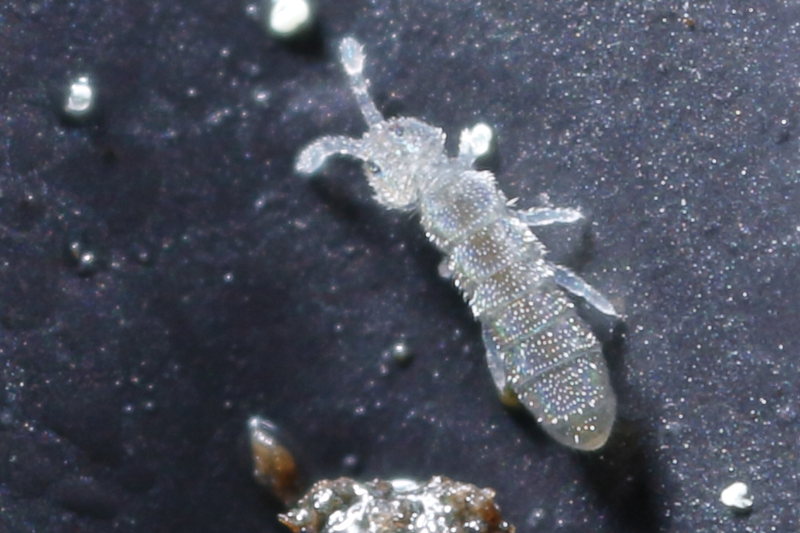
Parisotoma notabilis
Pseudisotoma sensibilis (Tullberg, 1876)
A springtail with a bluish color is Pseudisotoma sensibilis, a fairly common species, which I've not previously photographed. I just find the animal in the garden on a place where I have looked many times before. But what appears to be a suitable place for springtails. There is wood for the fireplace, that must be made still small and there are piles of stones that are intended for the garden. The abdomen segments 5 and 6 are fused.

Pseudisotoma sensibilis
Vertagopus arboreus (Linnaeus, 1758)
I often do find Vertagopus arboreus on the impregnated wood of the bench around the chestnut tree and under the loose bark of old wood. It are dark animals, from distance they appear to be black. By flash light or when the sun shines on it, the dense coat gets a blue shine. The young animals are pink in color.
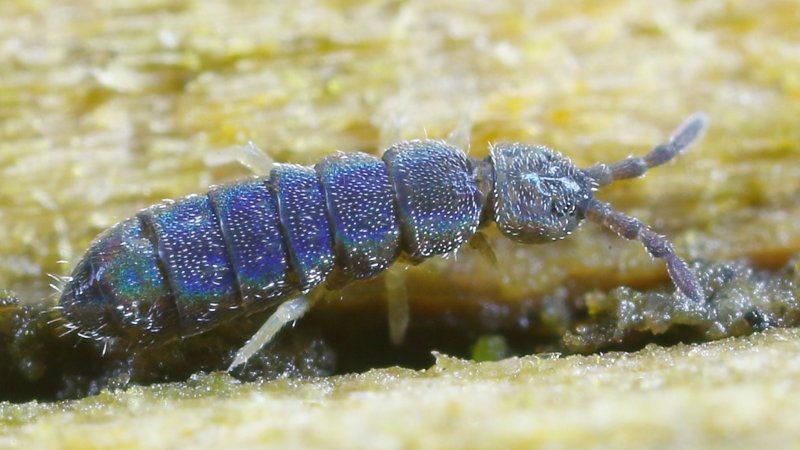
Vertagopus arboreus
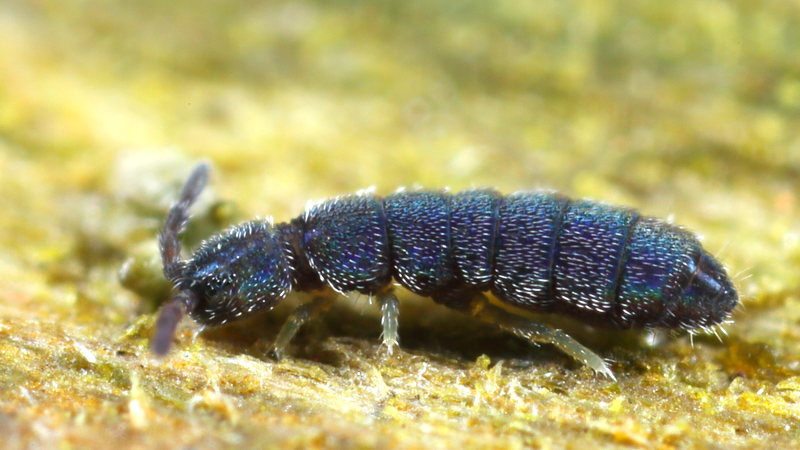
Vertagopus arboreus
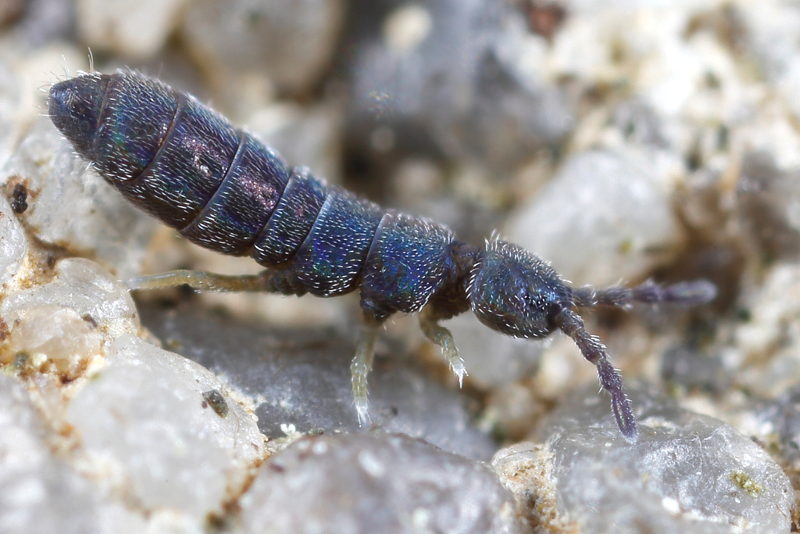
Vertagopus arboreus

Vertagopus arboreus with juvenile
Vertagopus pseudocinereus Fjellberg, 1975
Vertagopus pseudocinereus looks very similar to V. cinereus, the difference is again in the hair, this species has on all segments short macro setae (long hairs). Which you can see on the bottom picture where on each segment a longer hair is sticking out.
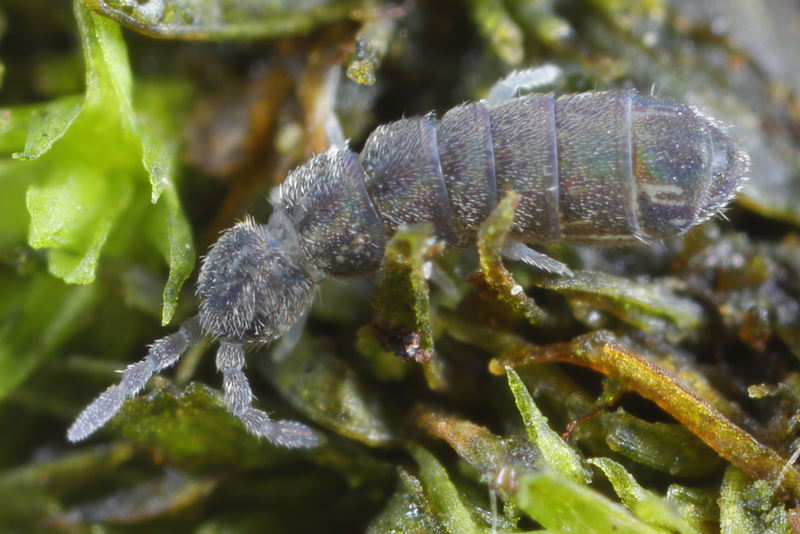
Vertagopus pseudocinereus

Vertagopus pseudocinereus
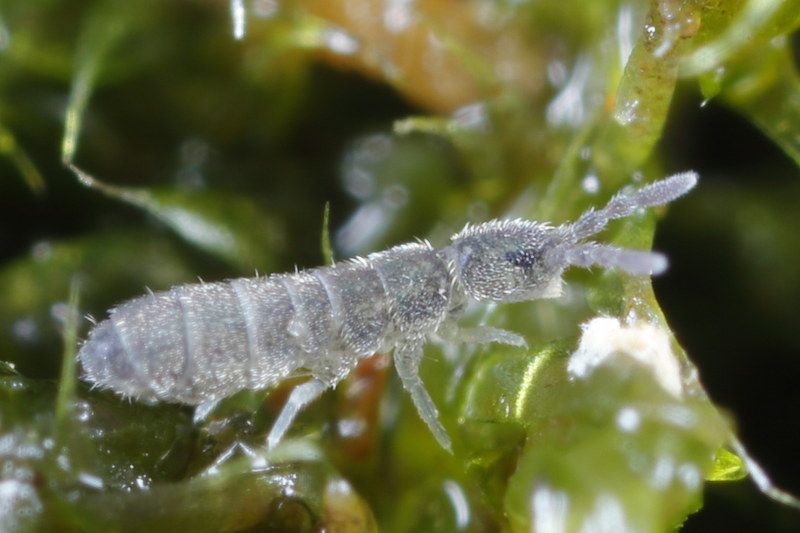
Vertagopus pseudocinereus
Coecobrya tenebricosa Folsom, 1902
A typical man following species is Coecobrya tenebricosa. You often find them in greenhouses and zoos. The animal of the photos comes from a park in Zaandijk from a place next to a stable where very many branches have located which are rotten. It is originally an Oriental species.

Coecobrya tenebricosa

Coecobrya tenebricosa
Later I found this species in the compost bin for kitchen waste.

Coecobrya tenebricosa

Coecobrya tenebricosa
Entomobrya albocincta (Templeton, 1835)
You can find Entomobrya albocincta on dead wood and under bark, it are fast animals that also can be found on drier places. This species is very easy to recognize. Behind the head first a dark piece, then a very light colored band, followed by four dark segments.

Entomobrya albocincta
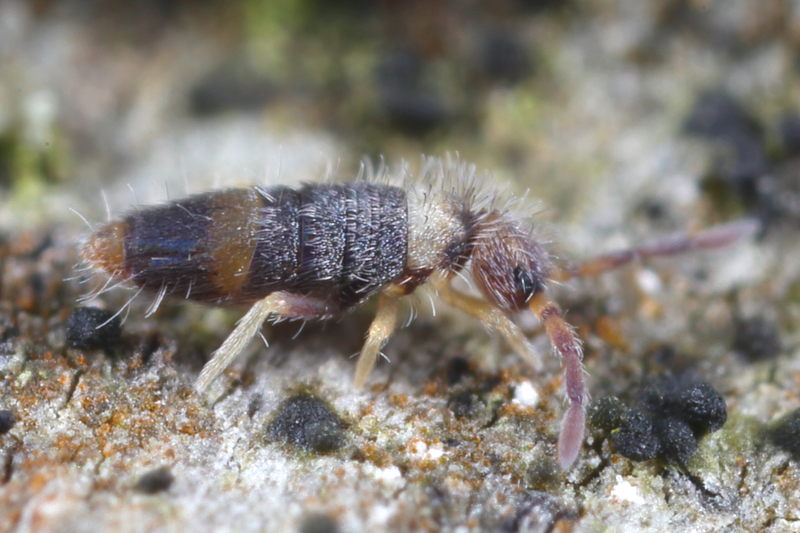
Entomobrya albocincta
Entomobrya corticalis (Nicolet, 1841)
Entomobrya corticalis is a species of dry spots, you will find them under loose bark on dead trees that has completely dried out and dead branches on heaths, that kind of places. The species is quite small, about 1.4 mm and they are very fast.
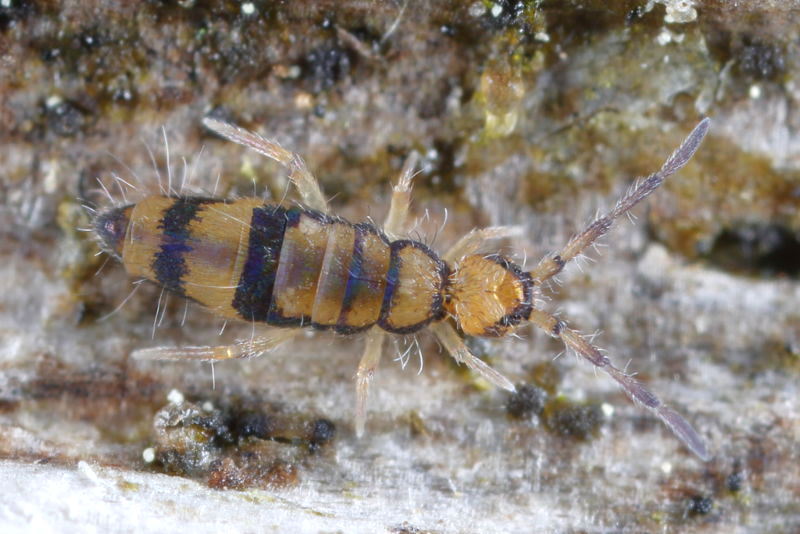
Entomobrya corticalis
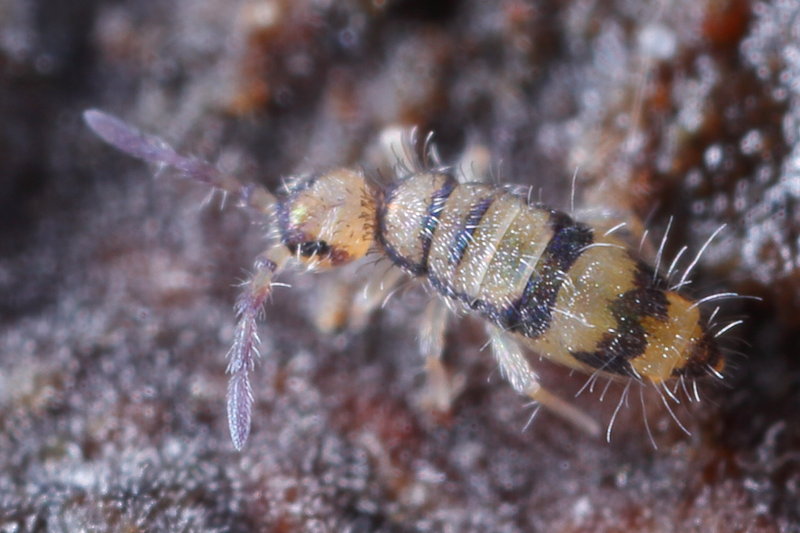
Entomobrya corticalis
Entomobrya lanuginosa (Nicolet, 1841)
A springtail that I only find in the clay on the coast, is all of a sudden on the letterbox where it is very easy to photograph. This animal has no drawing on its body, it has entirely one colour, with the typical hairs of this family.

Entomobrya lanuginosa
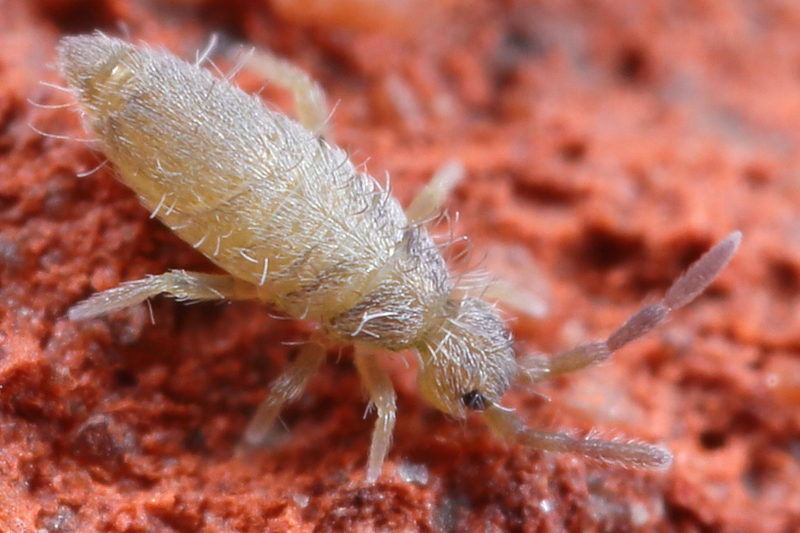
Entomobrya lanuginosa
Entomobrya marginata (Nicolet, 1841)
Yet another new springtail in the private garden, this time Entomobrya marginata. A springtail without drawing on the body but a dark border at the end of the segments and olive green.
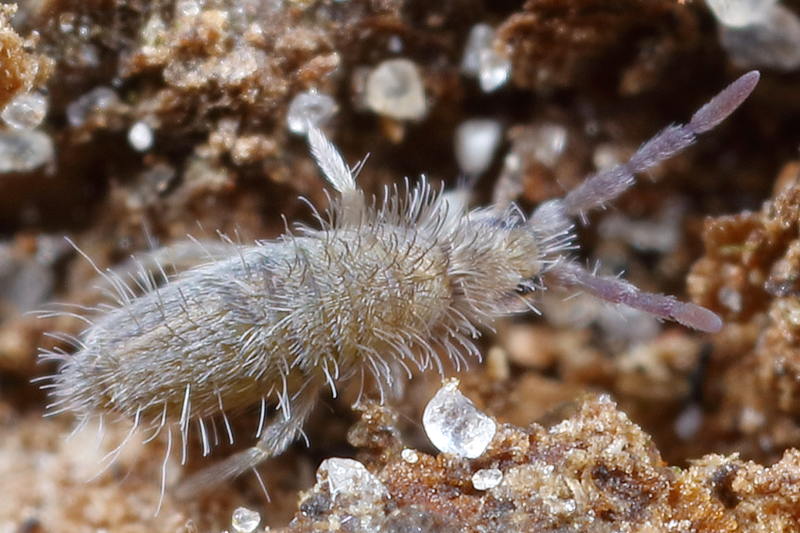
Entomobrya marginata
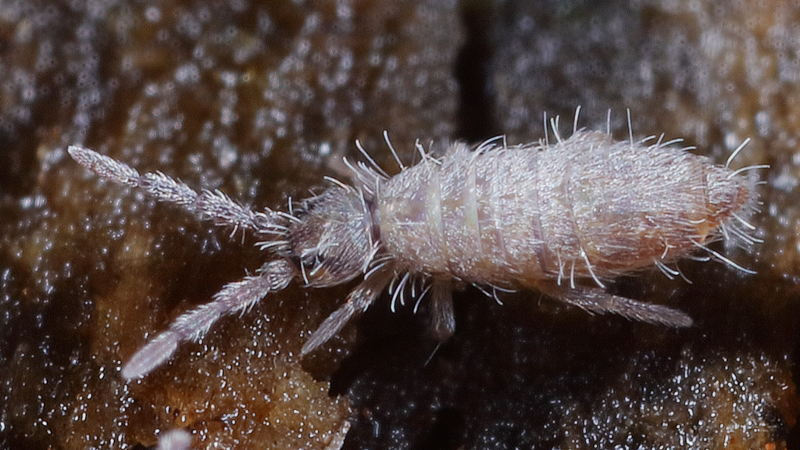
Entomobrya marginata
Entomobrya multifasciata (Tullberg, 1871)
(Entomobrya multifasciata) is a species you can find on many places, also on dry spots. Sites include: the basalt sea front, under dry wood on the Moor and in desiccated inflorescences of plants. They are swift mobile animals, which you can recognize to the cross stripes on the body and the forward-facing triangles drawing behind on the fourth abdominal segment.
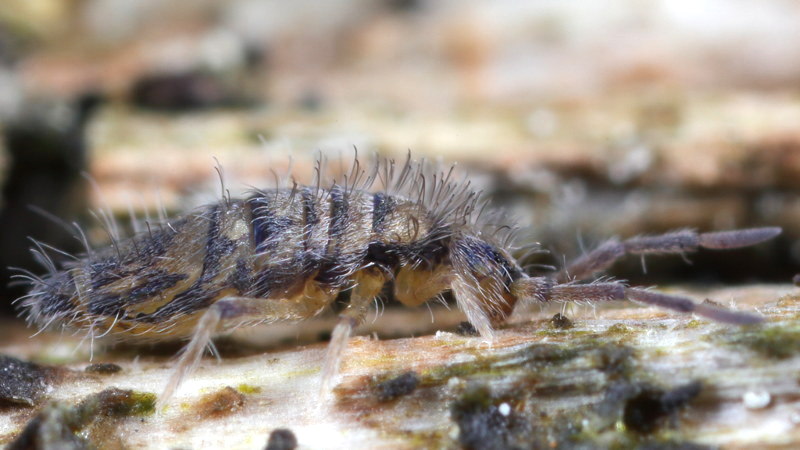
Entomobrya multifasciata
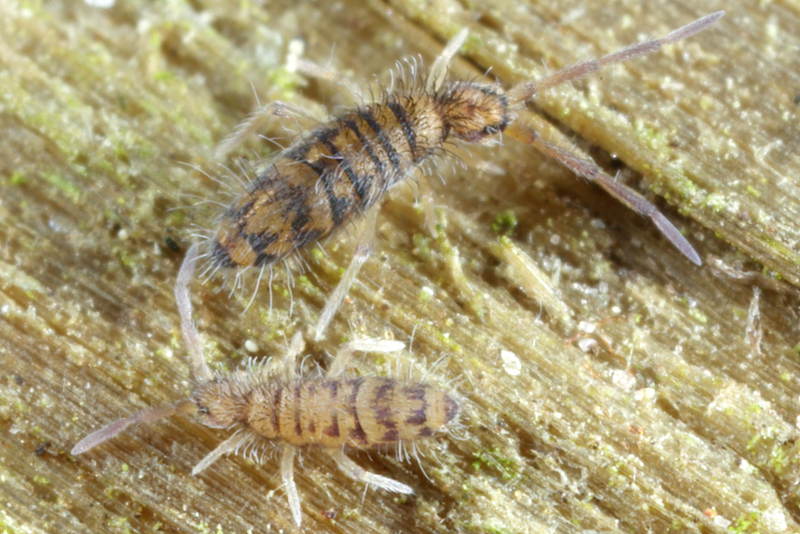
Entomobrya multifasciata
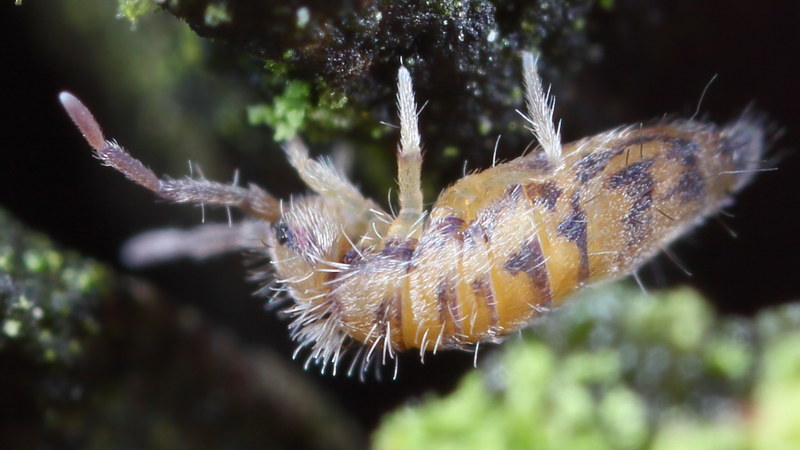
Entomobrya multifasciata

Entomobrya multifasciata
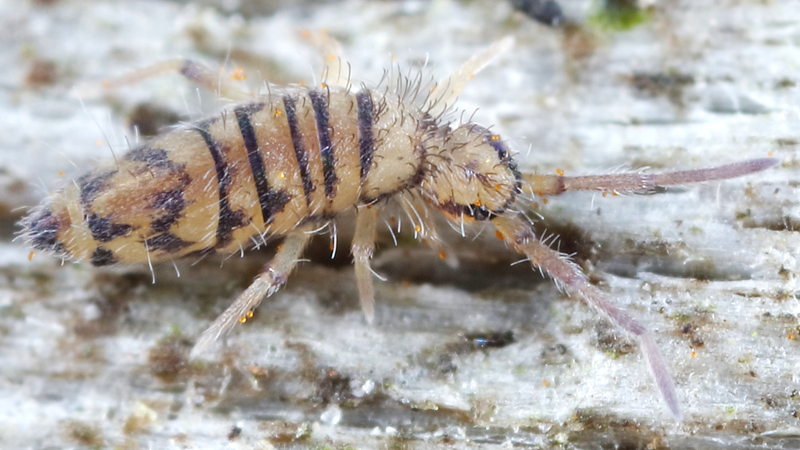
Entomobrya multifasciata
Entomobrya muscorum (Nicolet, 1842)
Entomobrya muscorum is a large species that I don't often see, so far only in old forests. It's a springtail with very long hairs on the legs and very long antennae. The back drawing is eye-catching, two lines on the back that are backwards interrupted, on the back of the body a cross line and behind it a dark spot.
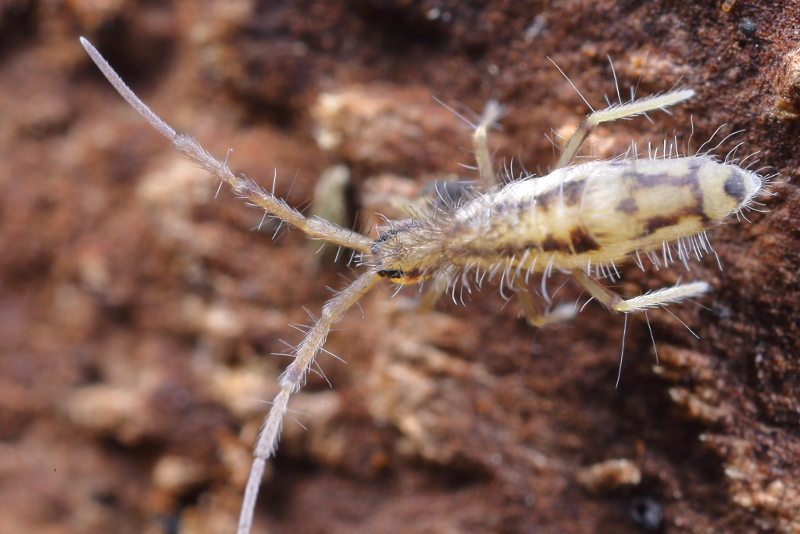
Entomobrya muscorum
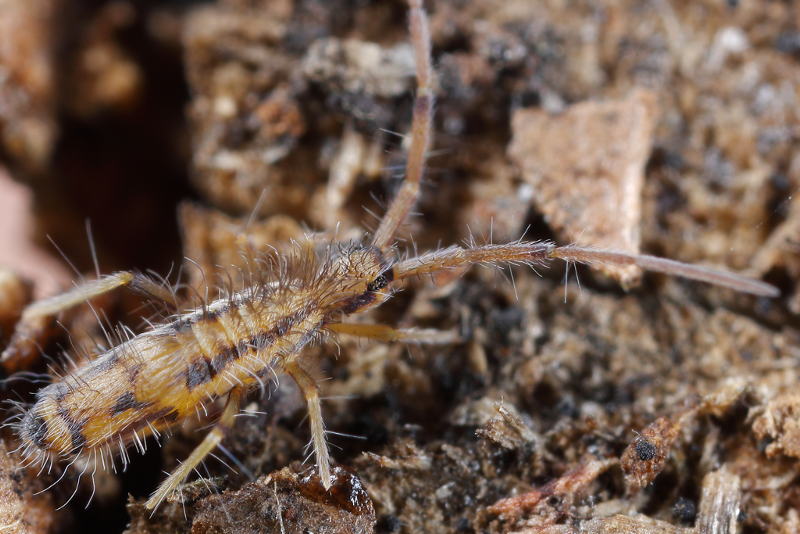
Entomobrya muscorum
Entomobrya nicoleti (Lubbock, 1867)
Entomobrya nicoletiis a species with only a few dark spots at the rear end of the body, further there are no spots. it is guyt common and often pretty yellow in color.

Entomobrya nicoleti
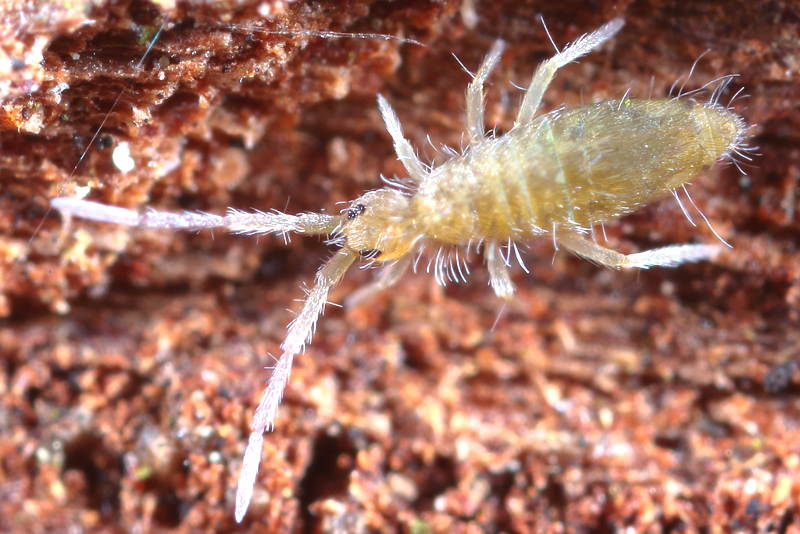
Entomobrya nicoleti
Entomobrya nigrocincta Denis, 1923
Entomobrya nigrocincta is found for the first time in the Netherlands on 2017-11-05 by Anne Krediet. The species is known from South European countries but also from Belgium and Germany. In this species is clear sexual dimorphism, the males differ in color and drawing from the females. The females are very similar to Entomobrya multifasciata but have two spots on the abdominal end and not an entirely dark segment.
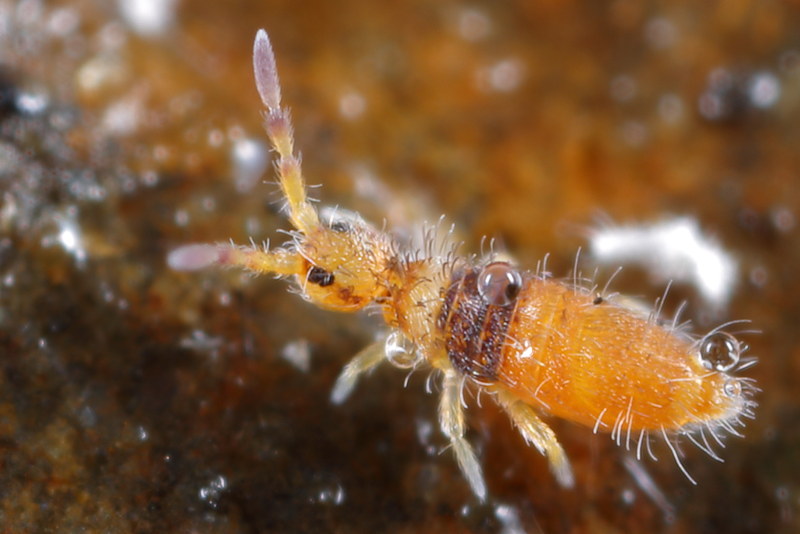
Entomobrya nigrocincta ♂
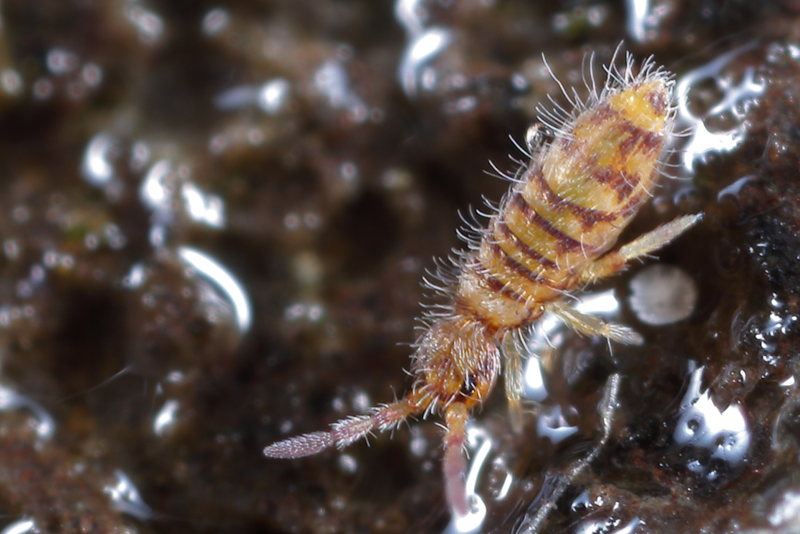
Entomobrya nigrocincta ♀
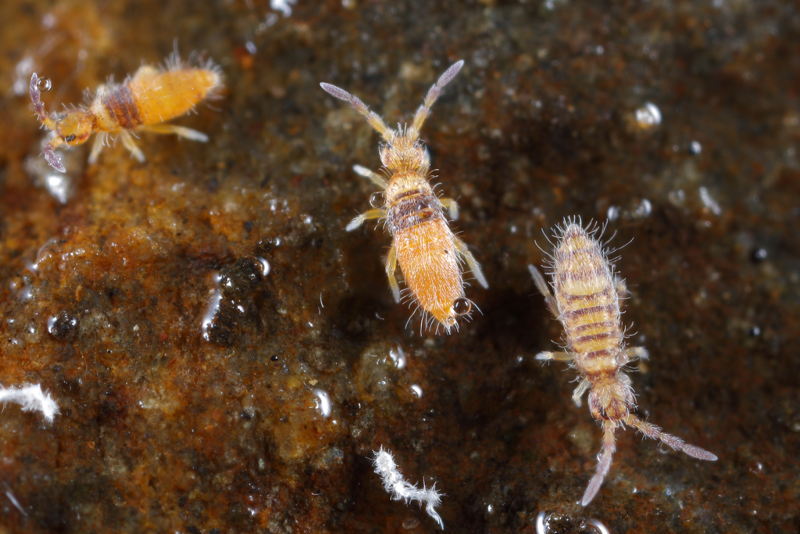
Entomobrya nigrocincta
Entomobrya nivalis (Linnaeus, 1758)
Entomobrya nivalis can be found on drier sites, often together with Entomobrya multifasciata, also on metal surfaces with algae growth. The species is clearly indicated by the figure behind on the body, two pulled out triangles with the point backwards and there connected by a thin line.

Entomobrya nivalis
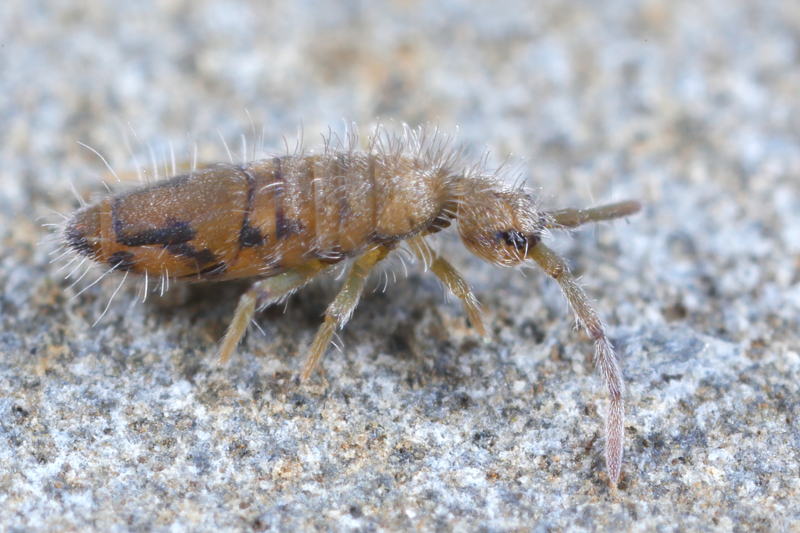
Entomobrya nivalis

Entomobrya nivalis
Entomobrya quinquelineata (Börner, 1901)
Entomobrya quinquelineata can be found under twigs in the Heath on the edge of inland sand dunes. It has a dense hair cover and not all pictures show good the length stripes. It is a relatively small species.
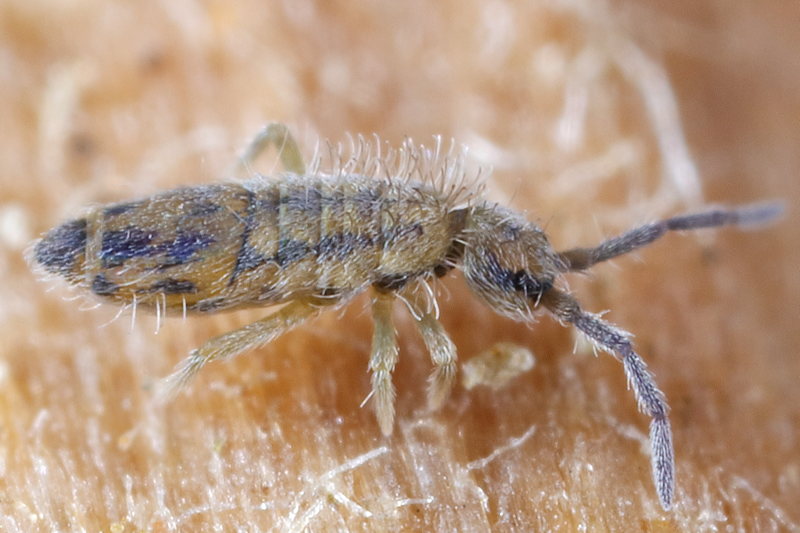
Entomobrya quinquelineata
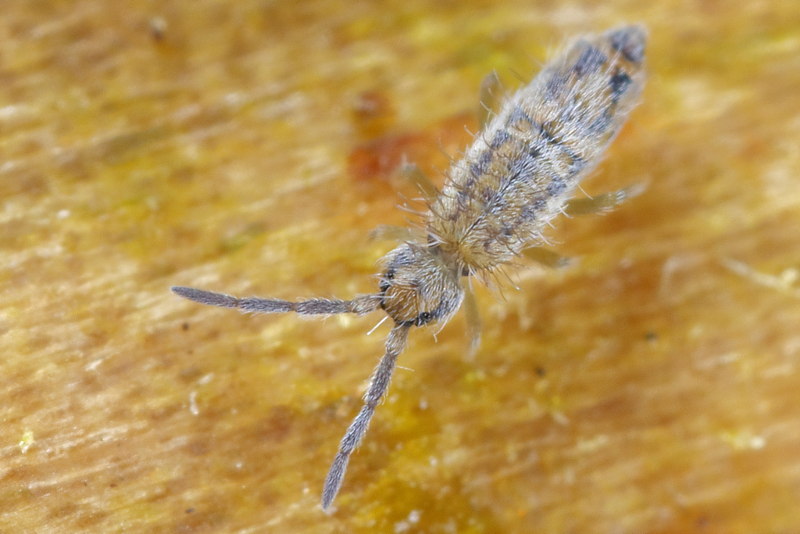
Entomobrya quinquelineata
Entomobrya schoetti Stach, 1922
Near Schoonloo is a nature area where I've found already very many species of springtails I regularly go look there because I expect the various species are not present throughout the entire year, so that you always will get a chance on a new species if you have not been there before at that certain time. Between a large number of Entomobrya multifasciata on a branch are 27-01-2015 some darker springtails and I don't know them. Frans Janssens comes up with the solution Entomobrya schoetti. The first sighting in The Netherlands

Entomobrya schoetti
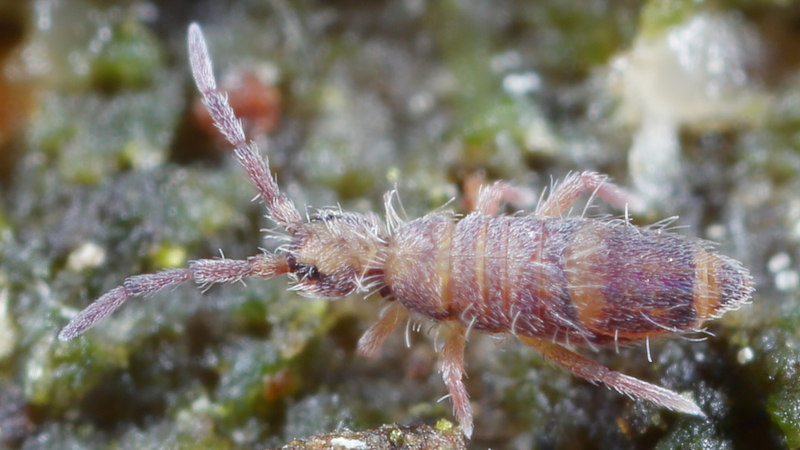
Entomobrya schoetti
Entomobrya unostrigata Stach, 1930
11-10-2012 To find a new kind of harvestman I have come with three other people to the Maasvlakte.
It is a beautiful day although it blows a little bit. At one point I go to look, protected from the wind by a dyke,
and turn pieces of wood and stone, that is already a fixed habit.
On one of the pieces runs a pretty big springstail that I not directly recognize. So take pictures.
That's not easy the animal continues to run and I need to get it sharp while it moves.
Of the four photos there actually succeed only one a little bit.
Unfortunately, a picture taken from the back and the head you can"t see.
However, the characteristics of these species are very clear.
A dark transverse stripe and dark spots on the middle of the back.
On collembola.org I first can
not find the animal and I put it with a question mark on Flickr.com.
Very soon Frans Janssens replied already. He gives the name of the animal Entomobrya unostrigata
and asks if I'm on vacation and whether I want to indicate the place where I found it.
The animal is known only from some South European countries and from the United States.
If I've done so it shows to be the first sighting in The Netherlands and northwestern Europe.
Description (sorry in Dutch):
Berg, M.P. & J.J. van Duinen 2014. De springstaart Entomobrya unostrigata nieuw voor Noordwest-Europa
(Hexapoda: Collembola: Entomobryidae). Nederlandse Faunistische Mededelingen 42: 63-70.
This article can be downloaded from the Naturalis website:
Entomobrya unostrigata (pdf)

Entomobrya unostrigata 11-10-2012

Entomobrya unostrigata 17-05-2014
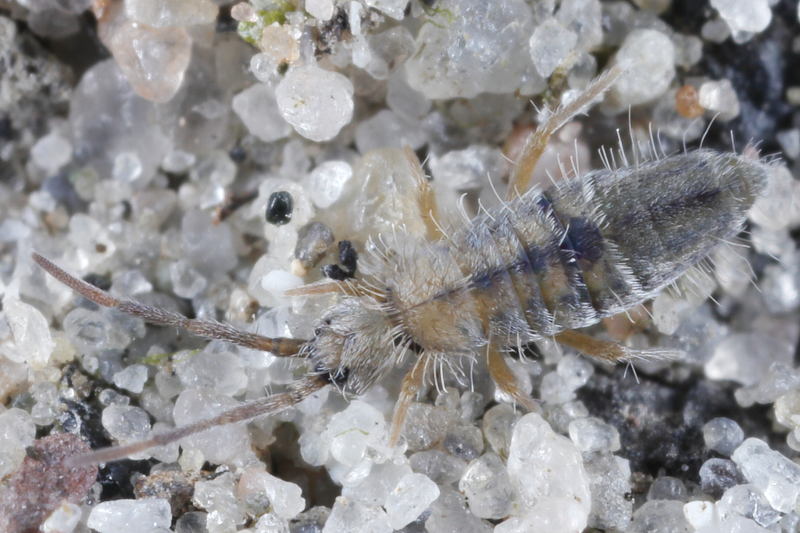
Entomobrya unostrigata 17-05-2014
Heteromurus major (Moniez, 1889)
A species that looks like a juvenile Tomoceridae is Heteromurus major. Nevertheless it is easy to distinguish. At Heteromurus the third and fourth segment of the antennae have the same length, the third segment in the Tomoceridae is much longer than the fourth.
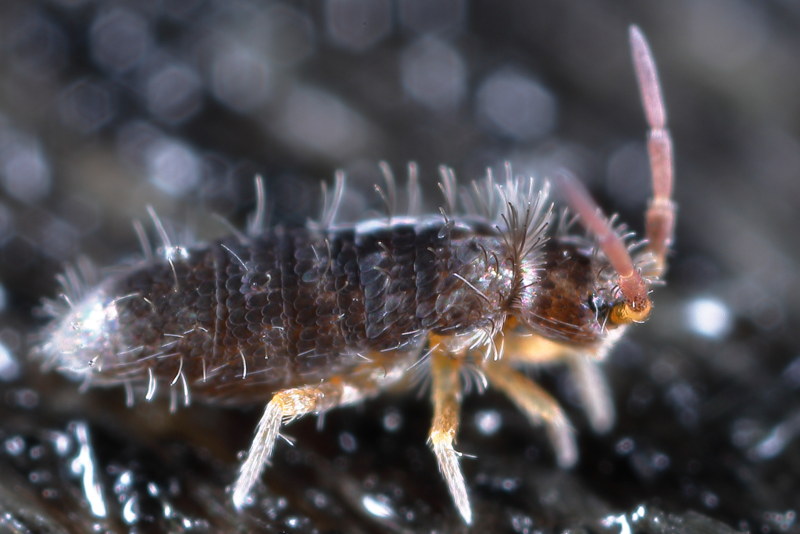
Heteromurus major
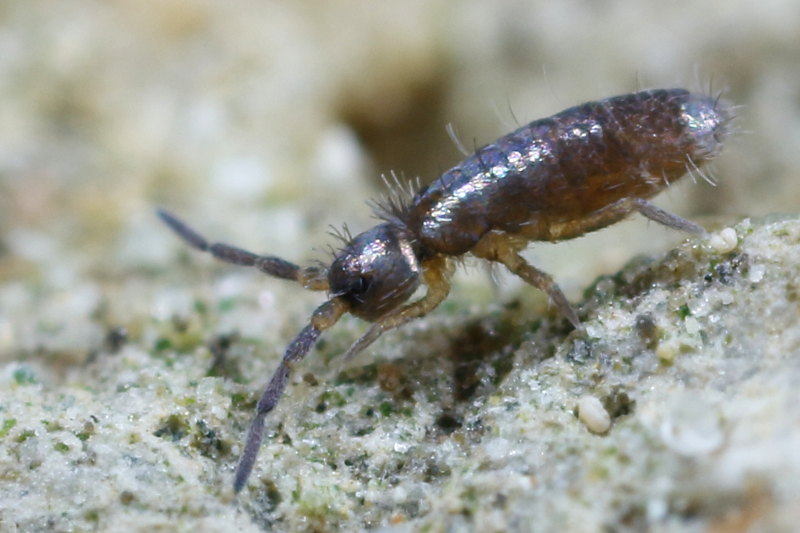
Heteromurus major
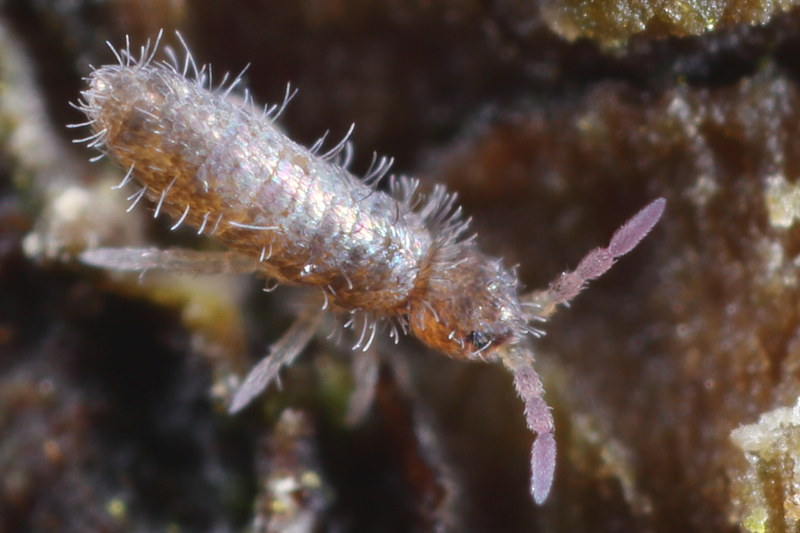
Heteromurus major juvenile
Heteromurus nitidus (Templeton, 1835)
Heteromurus nitidus you find usually deeper in the ground, under tree trunks, stones and also between the potatoes. The animal is bright white with a reddish eye-spot and the fourth antenna segment is ringed, but that is very difficult to see.

Heteromurus nitidus, geringd segment 4

Heteromurus nitidus

Heteromurus nitidus
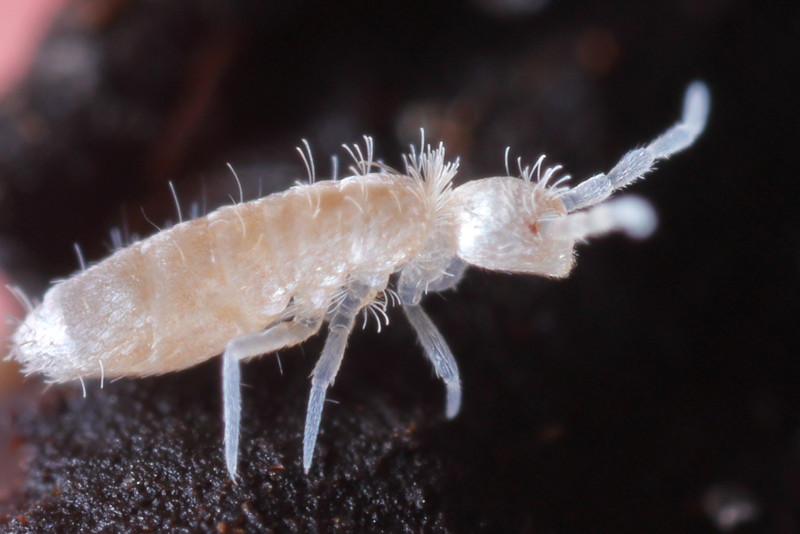
Heteromurus nitidus
Lepidocyrtus curvicollis Bourlet, 1839
In the greenhouse I find under a flowerpot on 16-02-2014 a springtail that stays put. The color is lighter than what I'm used to at the different species of Lepidocyrtus. It turns out to be Lepidocyrtus curvicollis, a species where the head is very far under the body. This is because the mesothorax makes an angle of almost 90 degrees. At Lepidocyrtus lignorum the angle is not as sharp, at Lepidocyrtus paradoxus (from which I have no picture yet) is the angle even sharper. That animal has a hunchback.
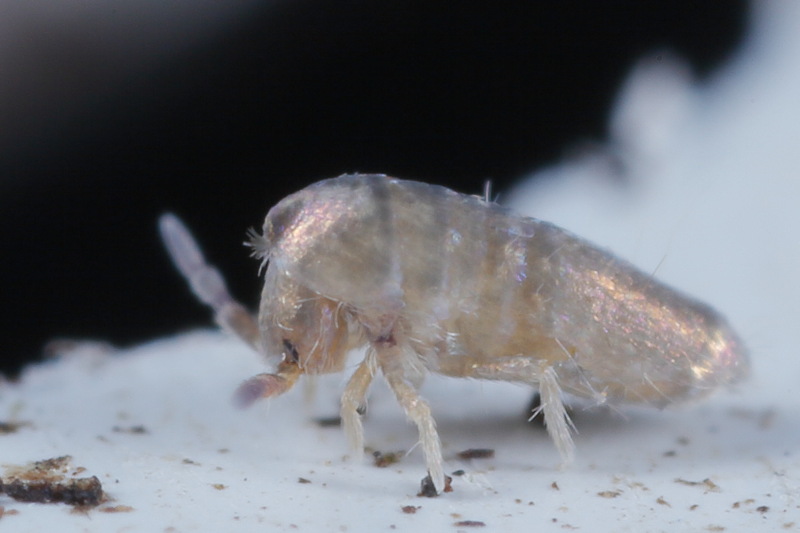
Lepidocyrtus curvicollis
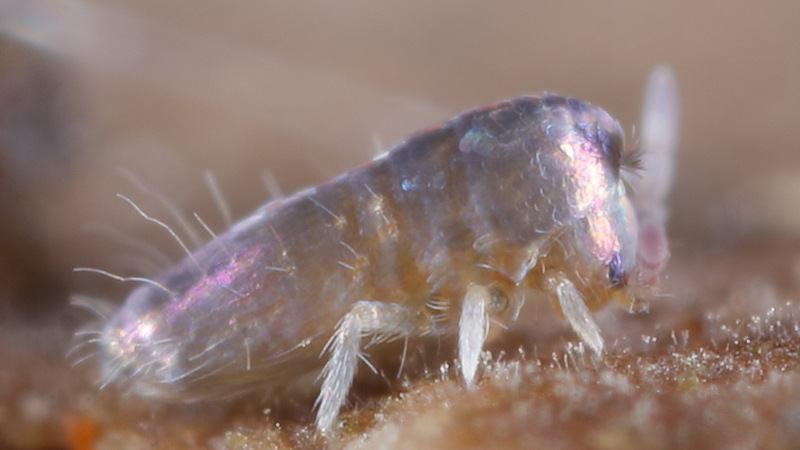
Lepidocyrtus curvicollis
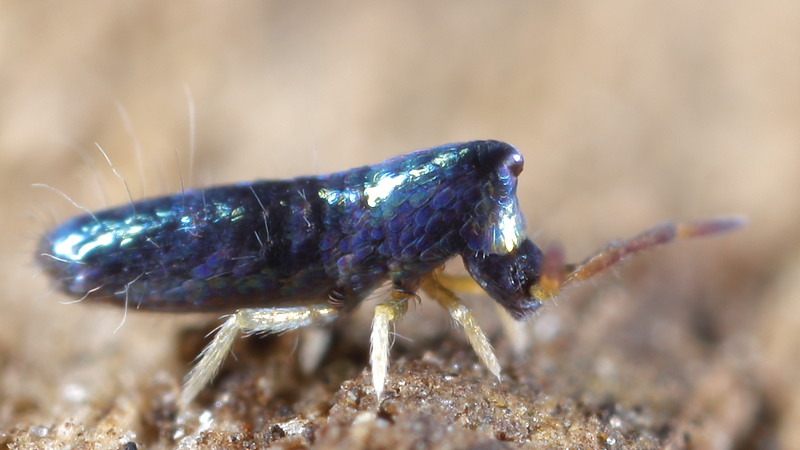
Lepidocyrtus curvicollis
Lepidocyrtus cyaneus Tullberg, 1871
Two pictures of Lepidocyrtus cyaneus the antennae and legs are scale-less, (no iridisation visible).
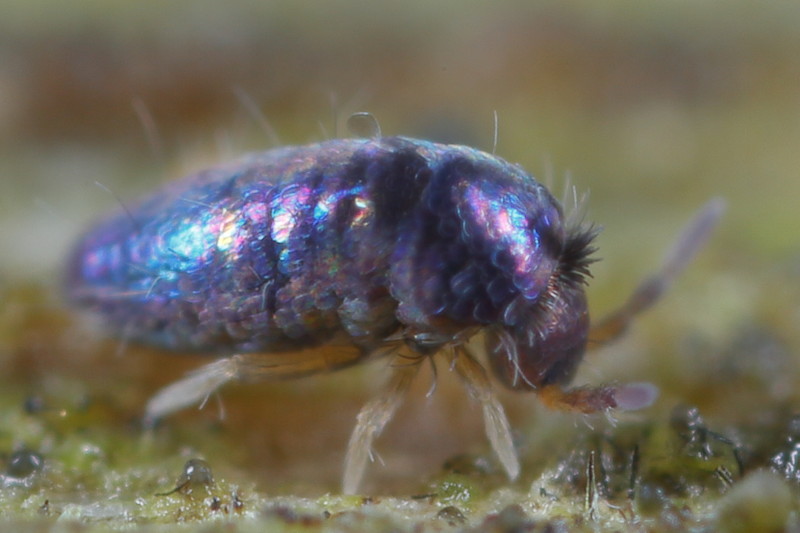
Lepidocyrtus cyaneus
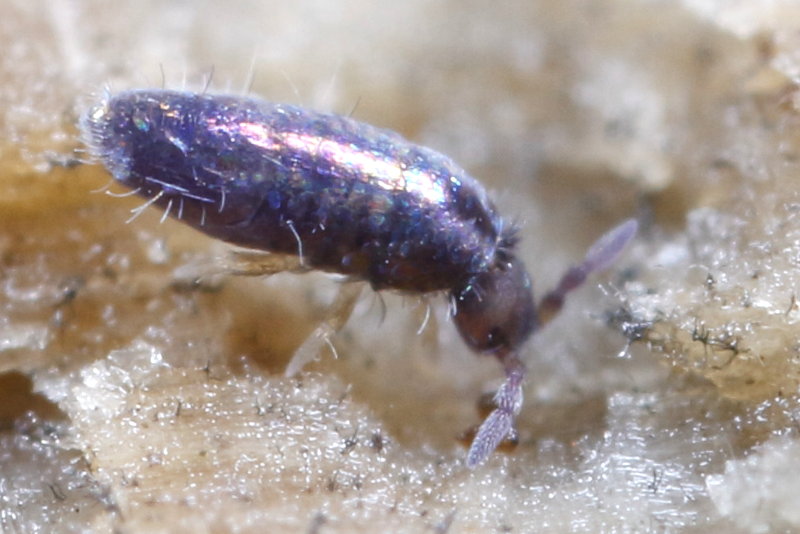
Lepidocyrtus cyaneus
Lepidocyrtus lignorum (Fabricius, 1781)
Pieces of old bark on the bottom are a good home for springtails. Many different species you can find underneath. If it is sunny the Lepidocyrtus species stands out inmediately. The animals sparkle beautifully blue and although they are very small you can see them directly. To distinguish the different species is not easy. The round eye is characteristic for Lepidocyrtus lignorum. Furthermore, there are scales on the first two parts of the antenna.
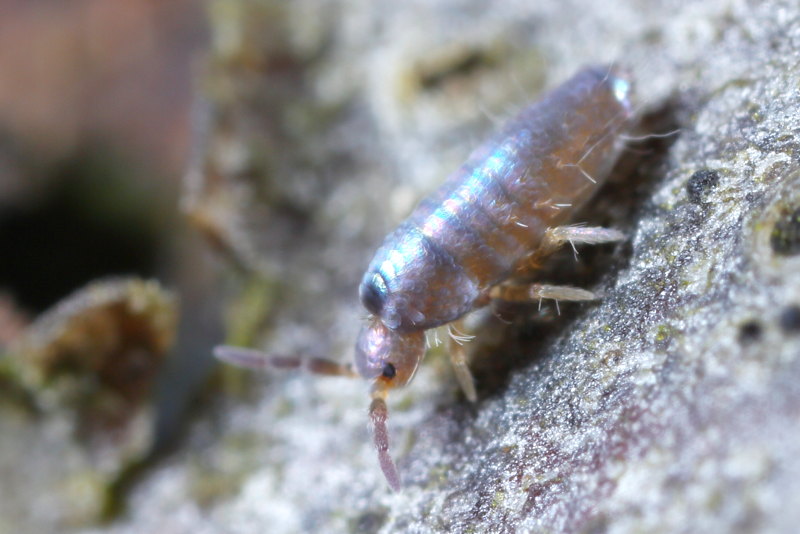
Lepidocyrtus lignorum
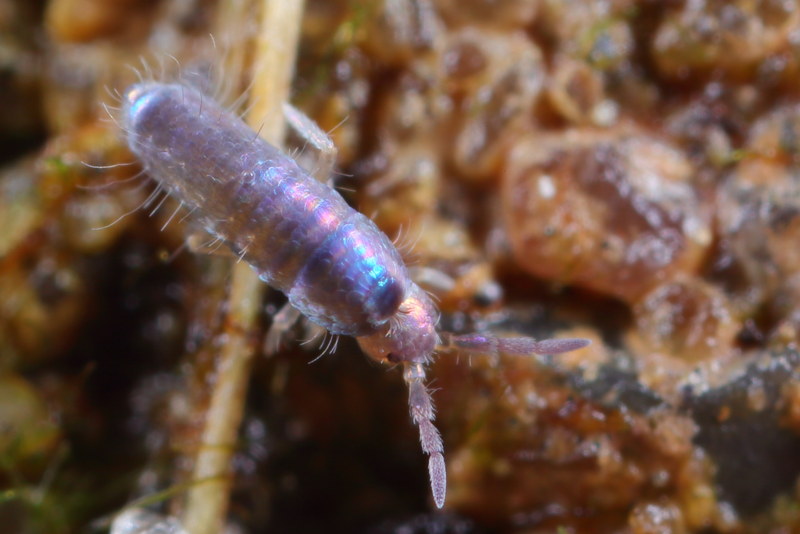
Lepidocyrtus lignorum
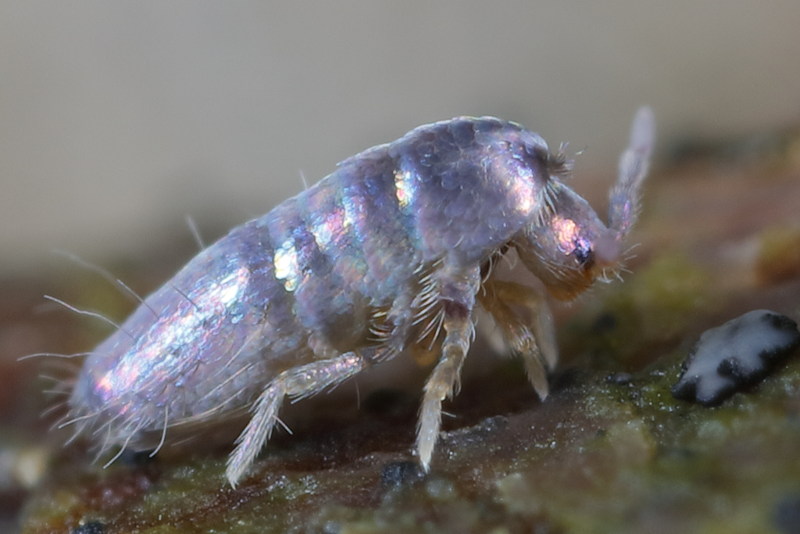
Lepidocyrtus lignorum
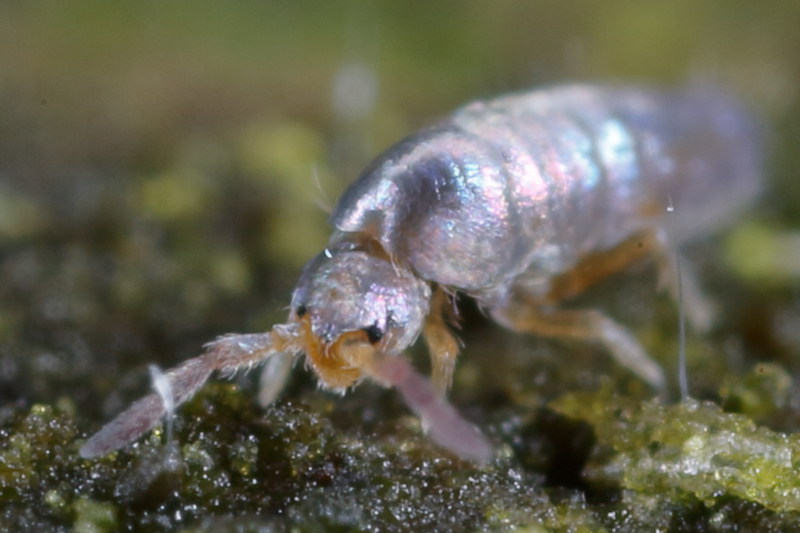
Lepidocyrtus lignorum
Lepidocyrtus violaceus Lubbock, 1873
A springtail with very intensive colors, found in a nature reserve around here. From this species are also photos on the general part of the springtails under: molting.
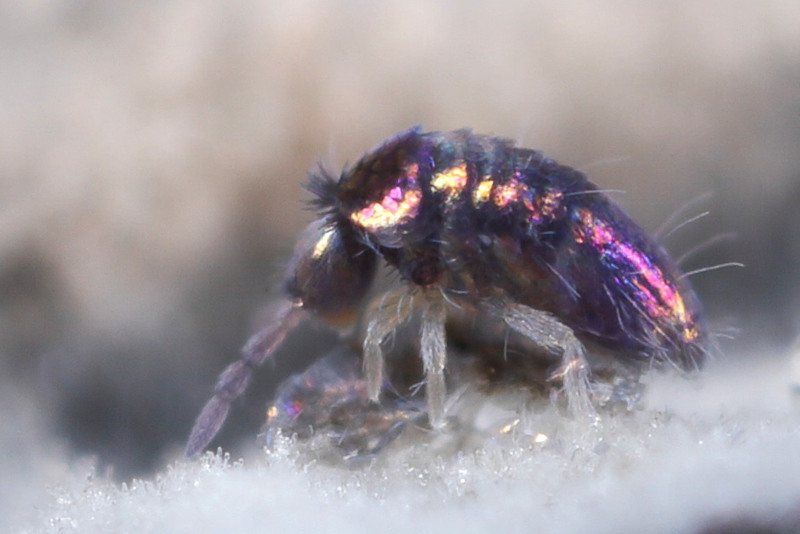
Lepidocyrtus violaceus
Orchesella cincta (Linnaeus, 1758)
Some springtails are to be photographed well, like this species Orchesella cincta.
It is a fairly large springtail and therefore somewhat easier to photograph. You see them throughout the year,
also quite high. When cleaning the gutters of the house there are many specimens of this kind between the leaves.
On the garden timber you can see them a lot and they remain seated quietly.
In these species there are often brown specimens which always seem to be females.

Orchesella cincta
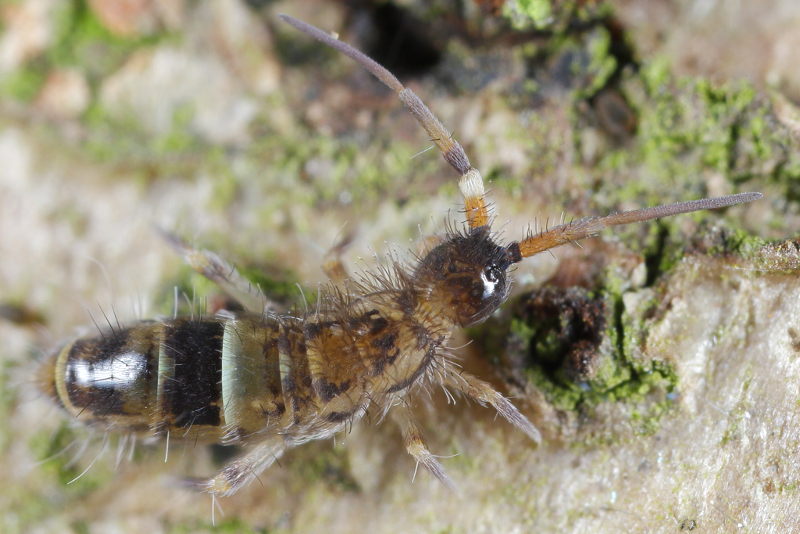
Orchesella cincta
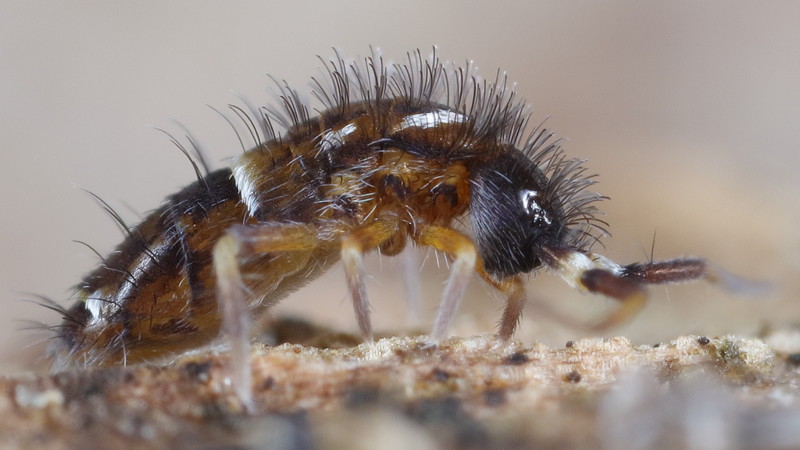
Orchesella cincta
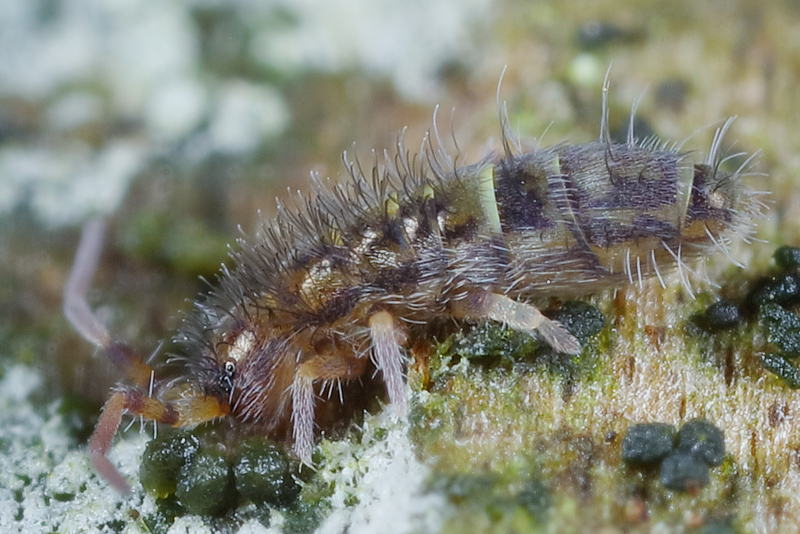
Orchesella cincta brown form
Orchesella flavescens (Bourlet, 1839)
Orchesella flavescens. This springtail can be large, up to 5 mm, it is a very fine beast with many brown colors. There is a color variant with dark head, (var. melanocephala).
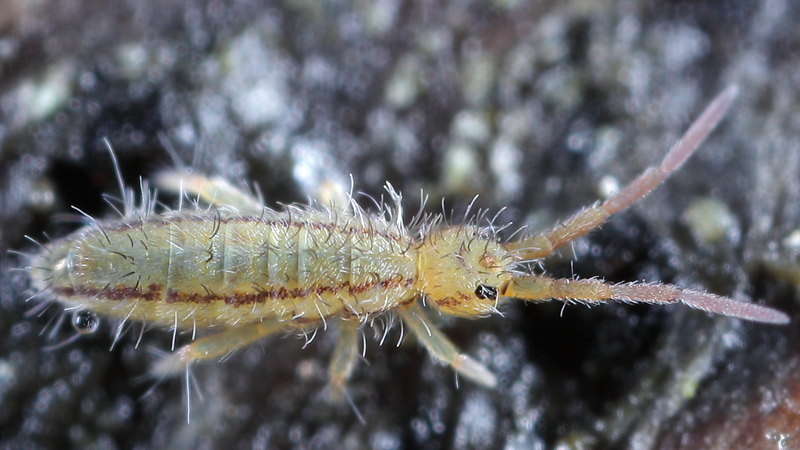
Orchesella flavescens, juvenile
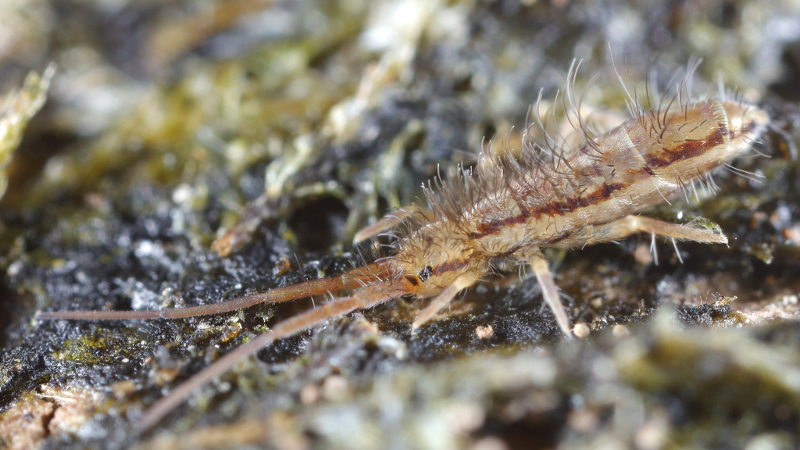
Orchesella flavescens
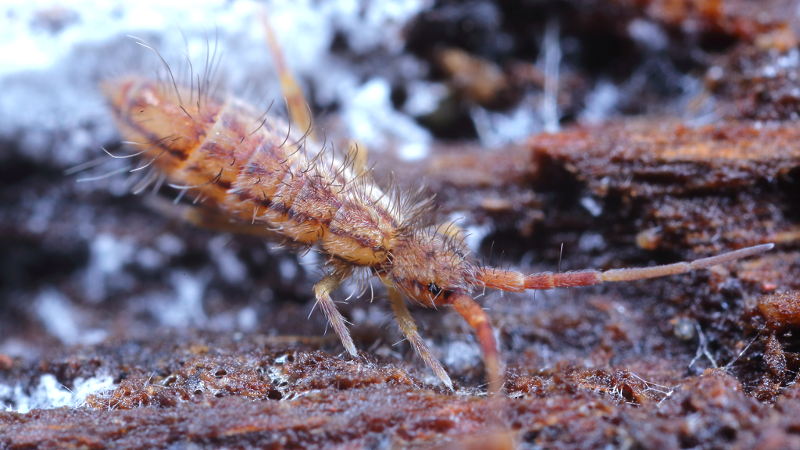
Orchesella flavescens
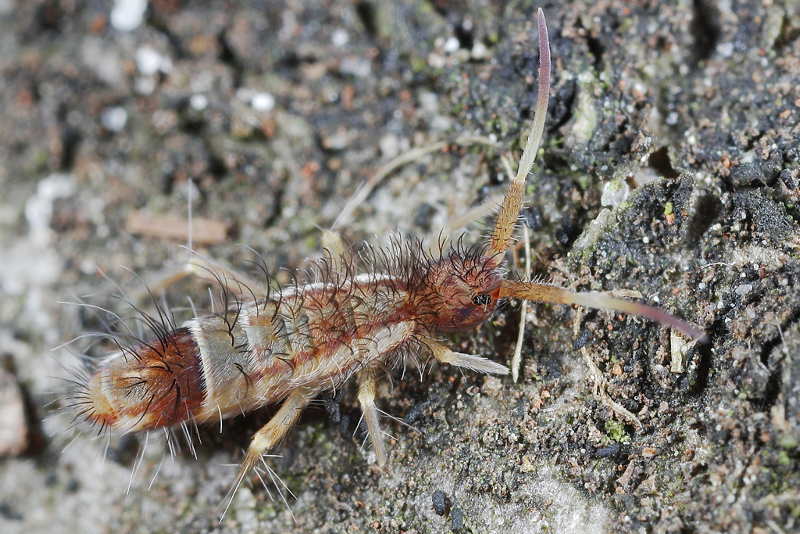
Orchesella flavescens
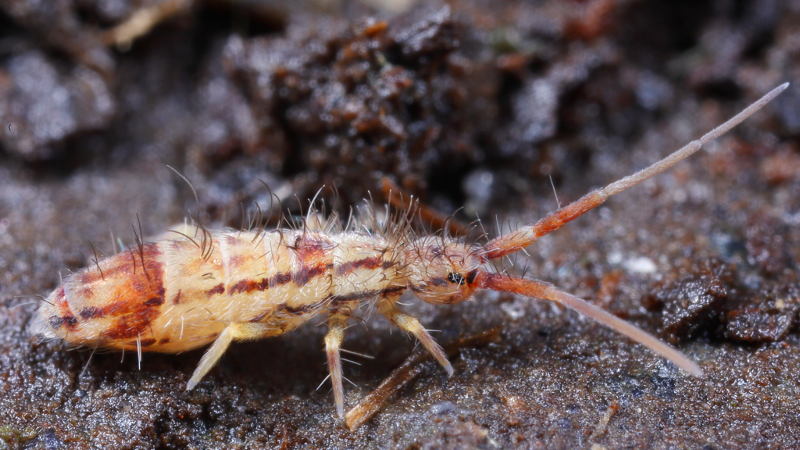
Orchesella flavescens
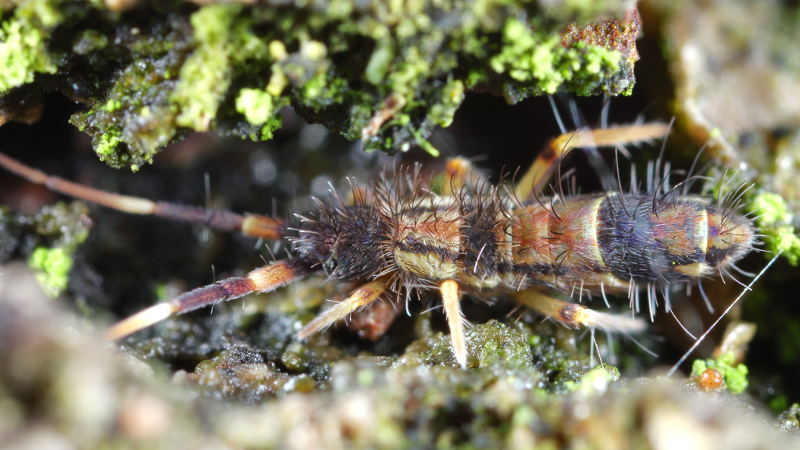
Orchesella flavescens
Orchesella quinquefasciata (Bourlet, 1842)
For a long time I search for the fourth Orchesella to be found in The Netherlands, Orchesella quinquefasciata, which you could find on heaths. I can't find this animal there. Then he sits just under a brick and under old boards on the inside of the dike at the Dollard. Here I definitely did not expected it. This animal is very similar to Orchesella flavescens, the difference is in the length stripes on the back, there are five of them at, O. quinquefasciata, one in the middle and on both sides two more. Furthermore, there is a dark stripe connecting the both antennal bases.

Orchesella quinquefasciata
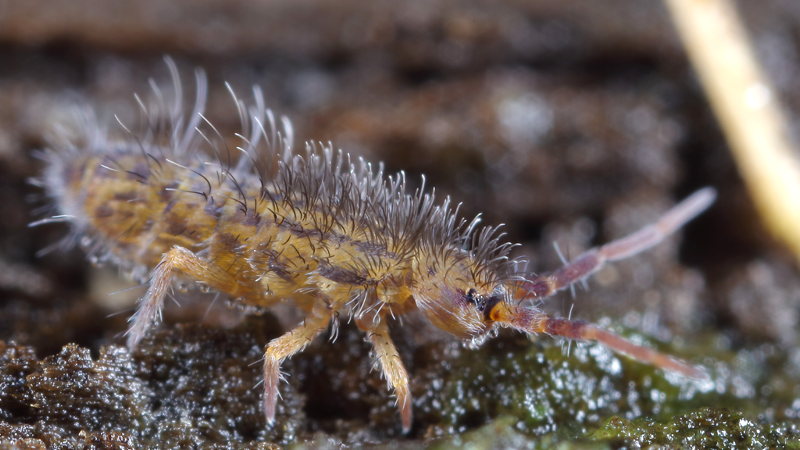
Orchesella quinquefasciata
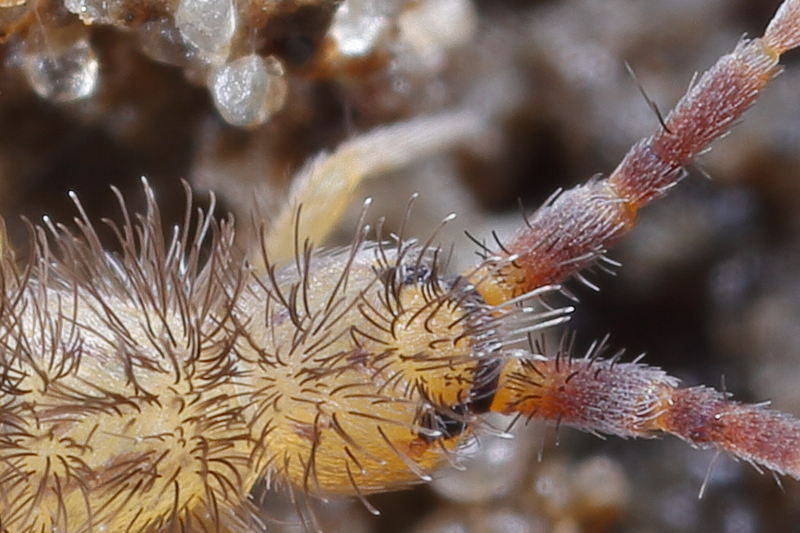
Orchesella quinquefasciata
Orchesella villosa (Geoffroy, 1764)
The springtail Orchesella villosa is a large species that is usually quite quiet. The animal I found on stones, branches, boards and tree trunks. The drawing is rather busy but length stripes do not appear.
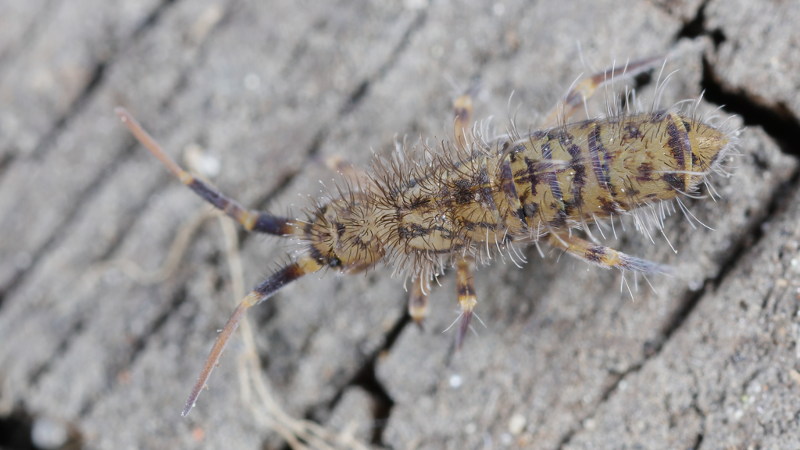
Orchesella villosa
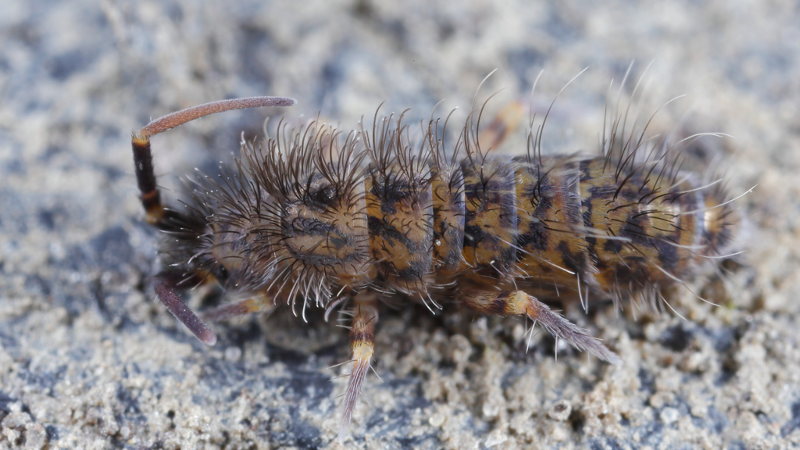
Orchesella villosa
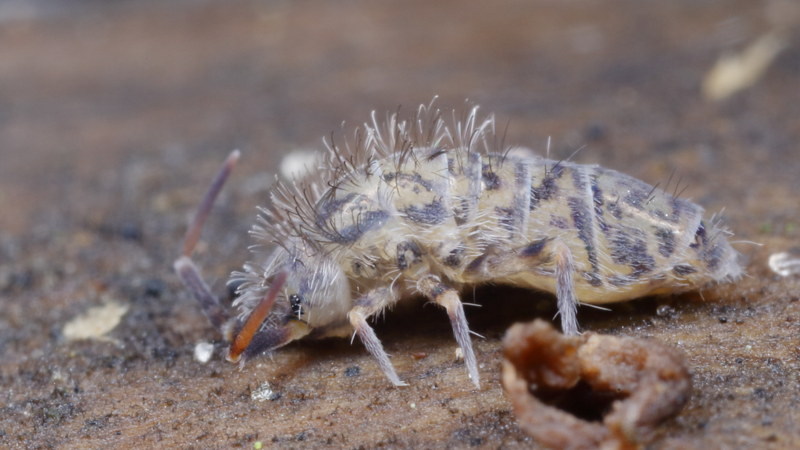
Orchesella villosa
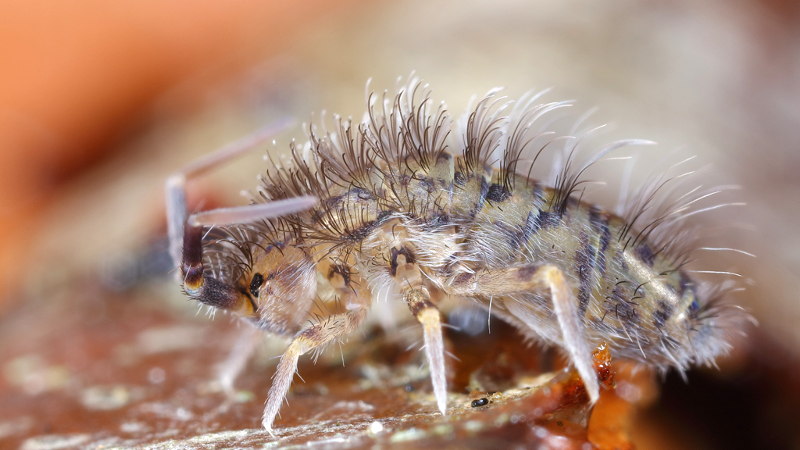
Orchesella villosa
Pseudosinella sp.
This blind white species I find under a piece of dead wood in the forest near my house. The animal is in the possession of scales and also has macro setae (long hairs). There are a number of species Pseudosinella in The Netherlands and I don't know if it is possible to give them a name from a photo.

Pseudosinella sp
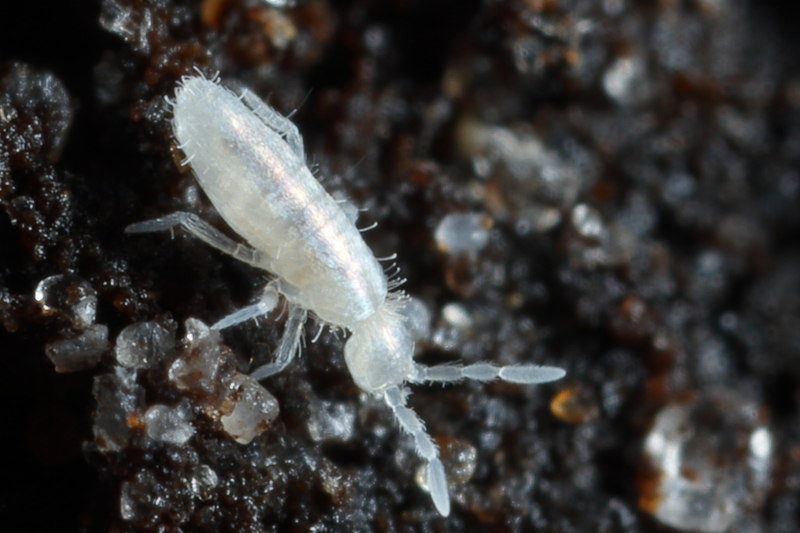
Pseudosinella sp
Sinella curviseta Brook, 1882
To feed the frogs, the next springtail Sinella curviseta comes out of the terrarium trade.
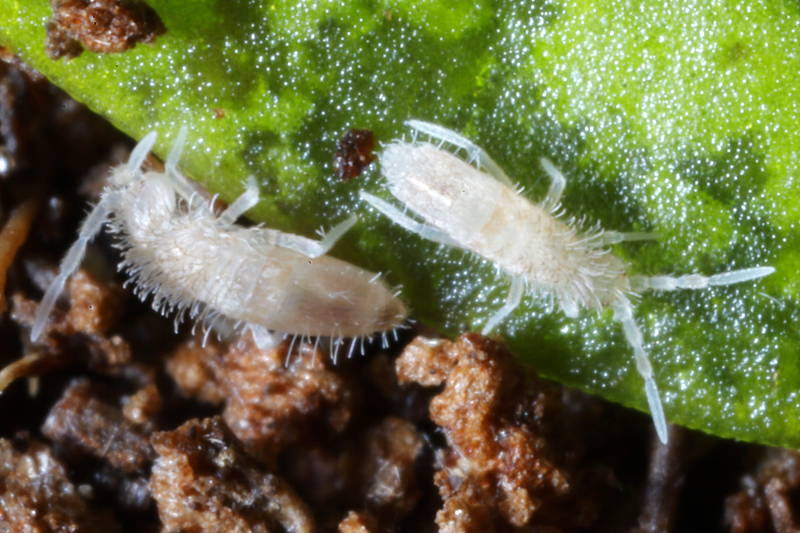
Sinella curviseta
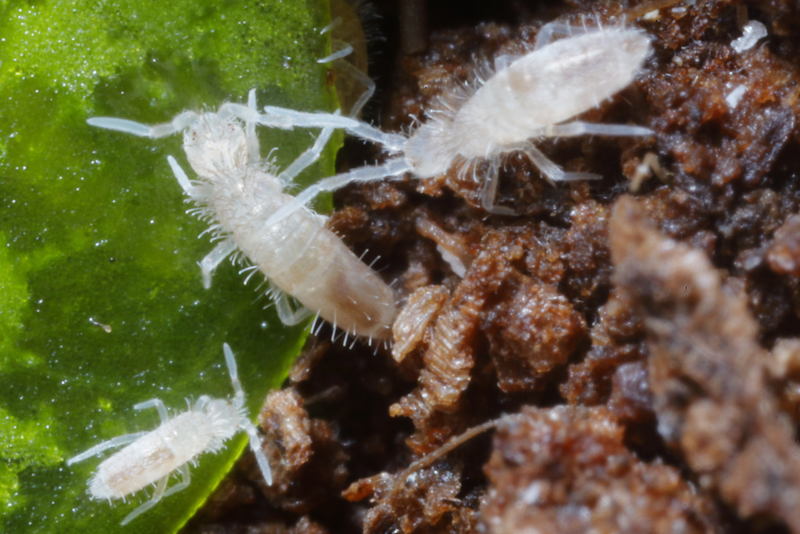
Sinella curviseta
Willowsia buski (Lubbock, 1869)
You sometimes do find springtails at home. That was the case with this species, Willowsia buski it was under a flowerpot with a fern. It is a small species, less than 1.5 mm. Especially if plants are kept fairly wet, springtails in the soil and under the pot and not rare. This species is known to occur frequently inside houses and greenhouses.
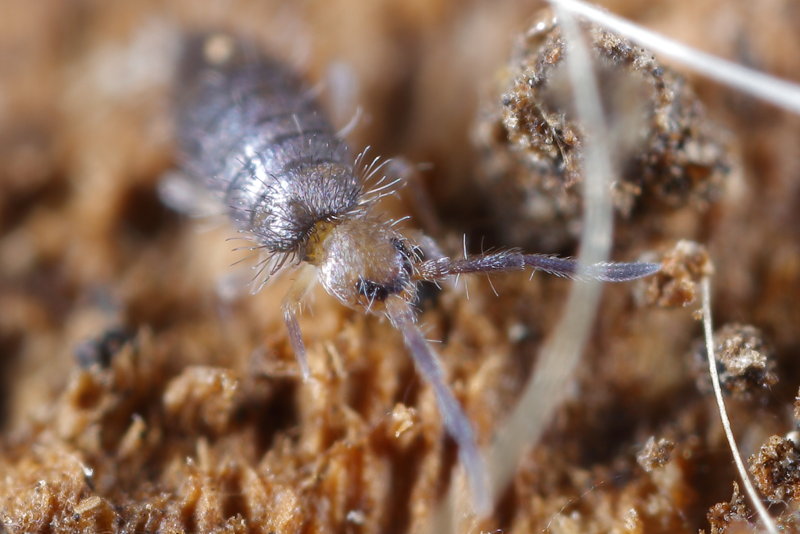
Willowsia buski
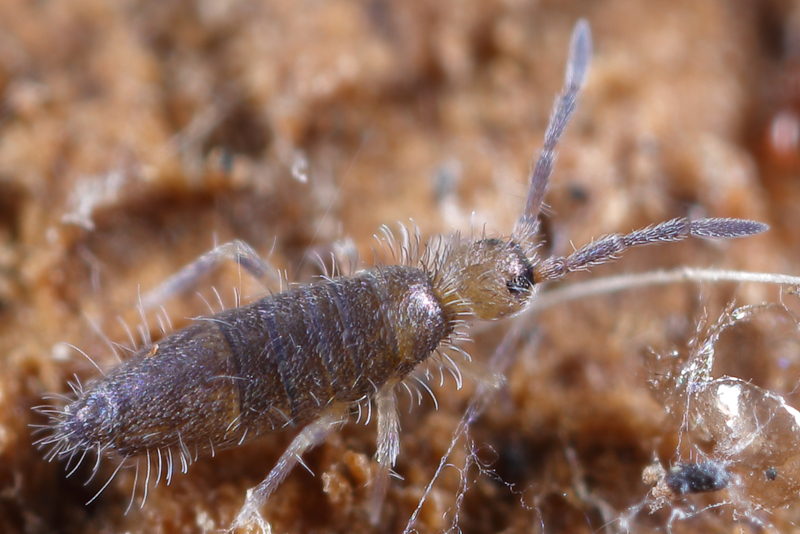
Willowsia buski

Willowsia buski
Willowsia nigromaculata (Lubbock, 1873)
10-08-2010 On the edge of the compost bin there are lately Willowsia nigromaculata. (Note the iridescent scales cover Frans Janssens) 22-06-2012 It is typically an animal that also lives in houses, it now sits under a flowerpot in the living room.
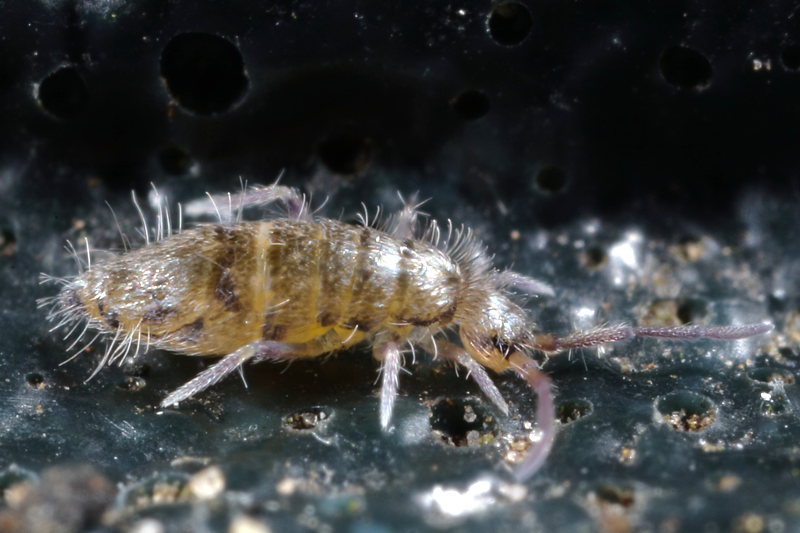
Willowsia nigromaculata

Willowsia nigromaculata
Willowsia platani (Nicolet, 1841)
For a long time now I pay attention to whether I encounter plane trees, but usually these trees are planted in the center of the village and to peel there pieces of bark from the tree and take pictures and look to this pieces with a magnifying glass, is still just a step too far for me. In the forest, many people will often wonder what I do there anyway. A plane tree in the forest near the monastery of Ter Apel brings outcome, there I can finally undisturbed take photos of Willowsia platani.
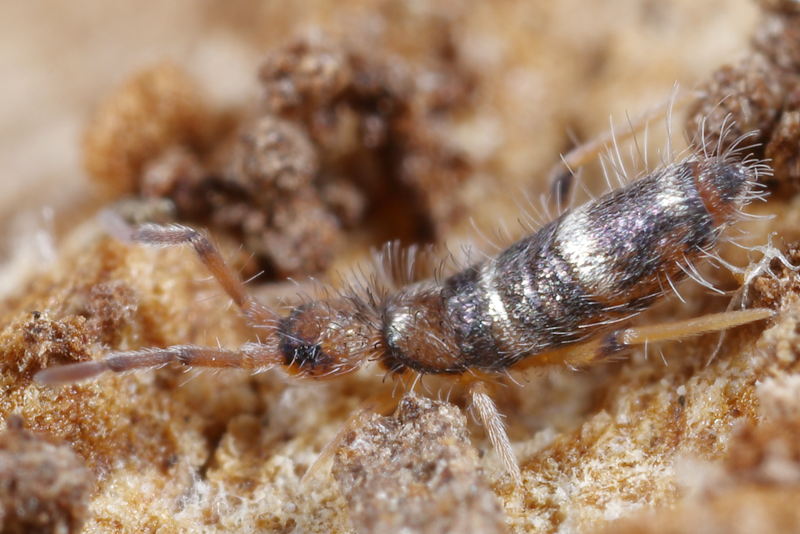
Willowsia platani
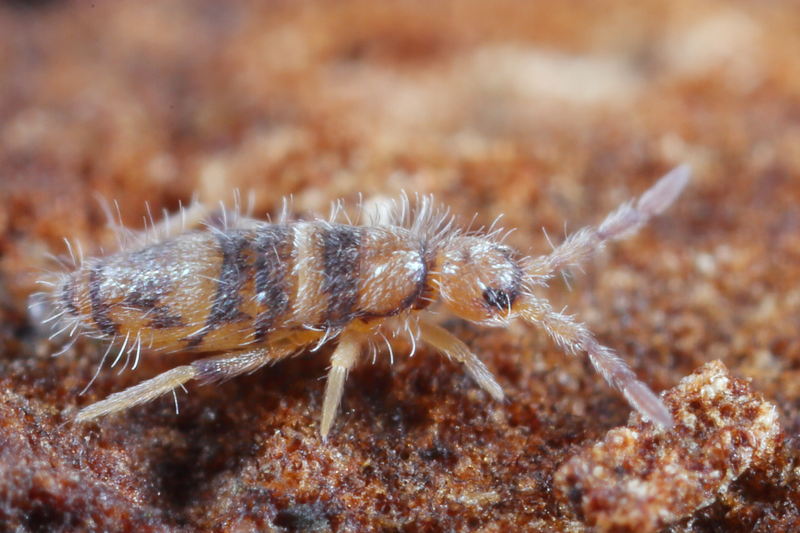
Willowsia platani
Pogonognathellus flavescens (Tullberg, 1871)
The springtail with the tongue-twisting name Pogonognathellus flavescens has very long antennae, which makes it easy to distinguish it from similar species Tomocerus. The ends of the antennae are thin and the animals curl the ends if there is blown against it. I regularly encounter this species in the forest.

Pogonognathellus flavescens
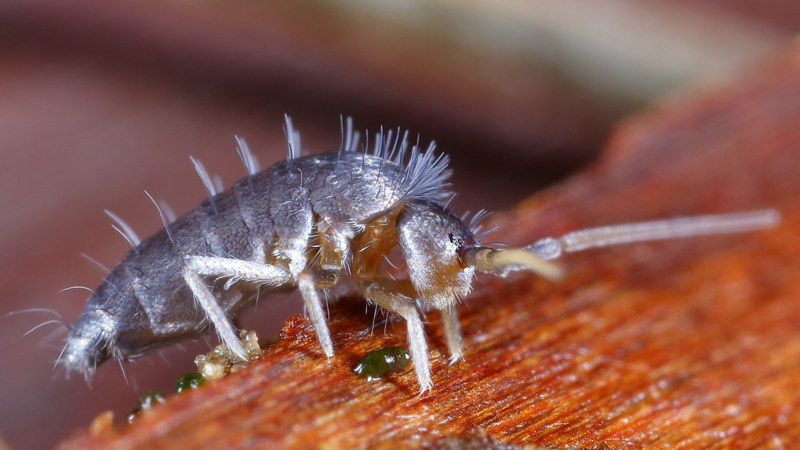
Pogonognathellus flavescens
Pogonognathellus longicornis (Müller, 1776)
A relative, Pogonognathellus longicornis, has even much longer antennae. As it has such long antennae, the species is not to be confused, but it happens that the antennas are shorter and than it is difficult to distinguish this species from the previous. I have the impression that this species is brownish in color the other Tomoceridae are not.

Pogonognathellus longicornis
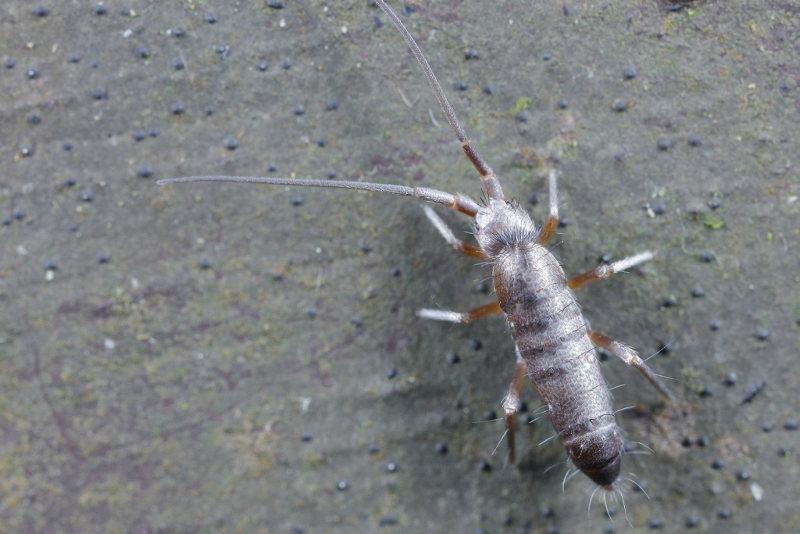
Pogonognathellus longicornis
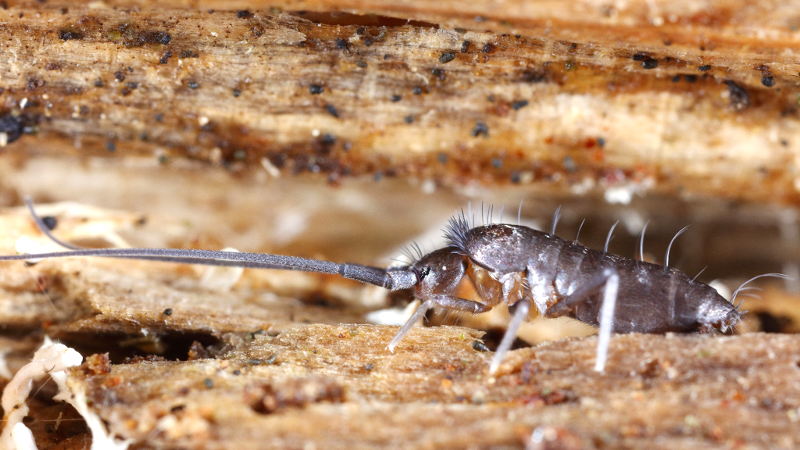
Pogonognathellus longicornis
Tomocerus minor (Lubbock, 1862)
Tomocerus minor is a very mobile species and difficult to photograph. It is very similar to Tomocerus vulgaris, but lacks the shiny bands around the body.
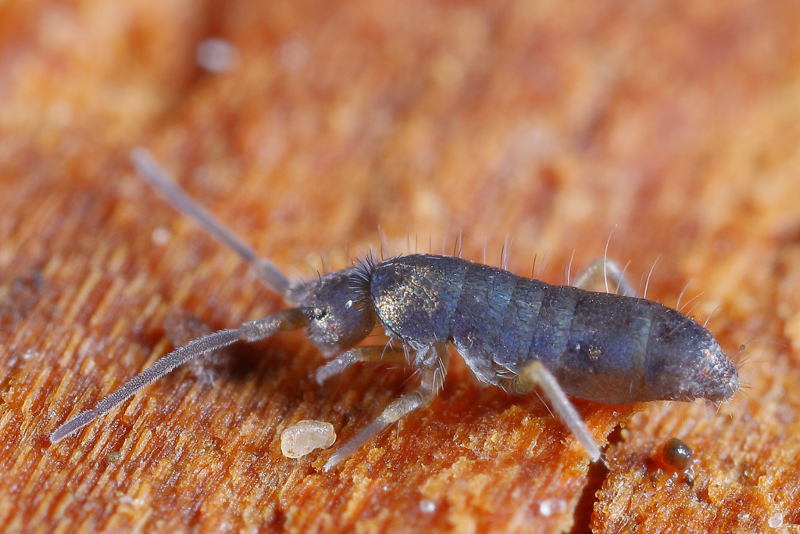
Tomocerus minor
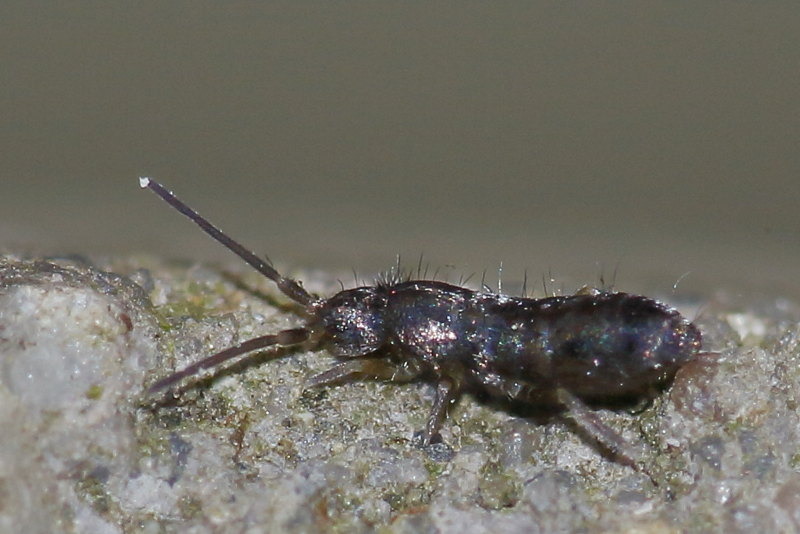
Tomocerus minor
Tomocerus vulgaris (Tullberg, 1871)
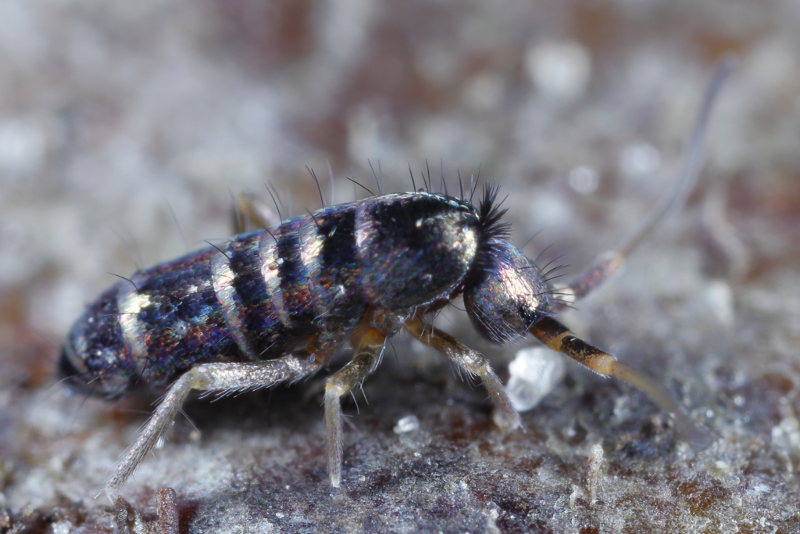
Tomocerus vulgaris
Under pieces of bark, stones and branches you can find Tomocerus vulgaris all year round. It is a fairly large species that can run very fast, often you can see them run on the wood pieces and than there is no possibility to photograph them. If you proceeds quietly, however, they remain sit still long, the ability to get a great shot. They have on the edge of the segments scales, that reflect light and gleam in the Sun like gold. By the shiny rings they are easy to identify. On the body are more reflective scales, so that the animal is often a feast of colors.
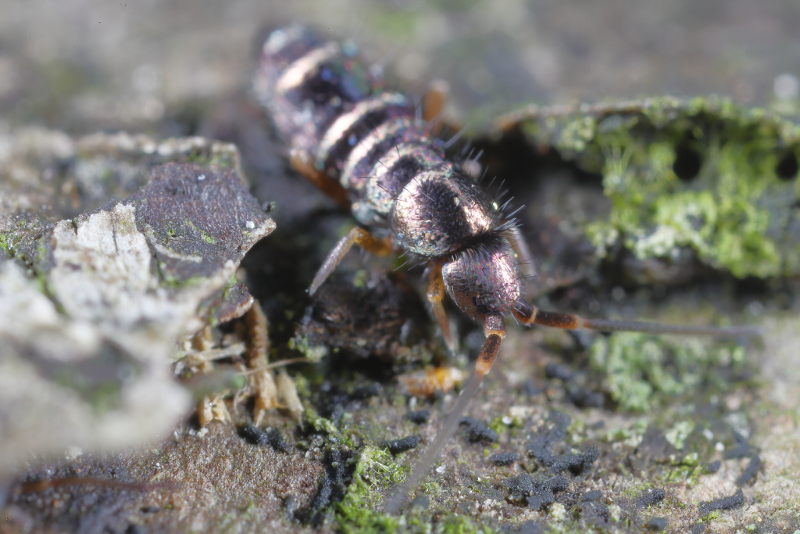
Tomocerus vulgaris
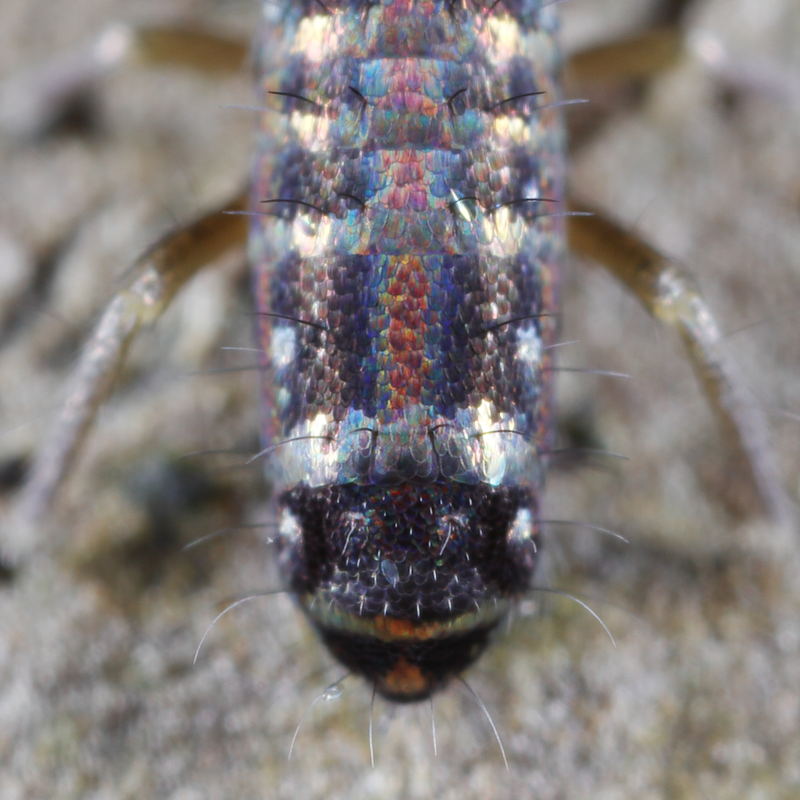
Tomocerus vulgaris
Overview species:
- Order: METAXYPLEONA Salmon, 1964
- Family: Poduridae Latreille, 1802-1803
- Podura aquatica Linnaeus, 1758
- Order: PODUROMORPHA Börner, 1913
- Family: Brachystomellidae Stach, 1949
- Brachystomella parvula (Schäffer, 1896)
- Family: Hypogastruridae Börner, 1906
- Ceratophysella bengtssoni (Agren, 1904)
- Ceratophysella denticulata (Bagnall, 1941)
- Ceratophysella gibbosa (Bagnall, 1940)
- Hypogastrura burkilli Weidner, 1953
- Hypogastrura distincta (Axelson, 1902)
- Hypogastrura viatica (Tullberg, 1872)
- Schaefferia sp.
- Xenylla grisea Axelson, 1900
- Xenylla maritima Tullberg, 1869
- Family: Neanuridae Börner, 1901
- Anurida granaria (Nicolet, 1847)
- Anurida maritima (Guérin-Méneville, 1836)
- Bilobella braunerae (Deharveng, 1981)
- Monobella grassei (Denis, 1923)
- Neanura muscorum (Templeton, 1835)
- Pseudachorutes sp.
- Family: Onychiuridae Börner, 1901
- Subfamily: Onychiurinae Börner, 1901
- Onychiurus edinensis (Bagnall, 1935)
- Protaphorura armata (Tullberg, 1869)
- Subfamily: Tullbergiinae Deharveng L, 2004
- Paratullbergia callipygos (Börner, 1902)
- Order: ENTOMOBRYOMORPHA Börner, 1913
- Family: Cyphoderidae Börner, 1913
- Cyphoderus albinus Nicolet, 1847
- Family: Entomobryidae Schött, 1891
- Coecobrya tenebricosa (Folsom, 1902)
- Entomobrya albocincta (Templeton, 1835)
- Entomobrya corticalis (Nicolet, 1841)
- Entomobrya lanuginosa (Nicolet, 1841)
- Entomobrya marginata (Tullberg, 1871)
- Entomobrya multifasciata (Tullberg, 1871)
- Entomobrya muscorum (Nicolet, 1842)
- Entomobrya nicoleti (Lubbock, 1867)
- Entomobrya nigrocincta Denis, 1923
- Entomobrya nivalis (Linnaeus, 1758)
- Entomobrya quinquelineata Börner, 1901
- Entomobrya schoetti Stach, 1922
- Entomobrya unostrigata Stach, 1930
- Heteromurus major (Moniez, 1889)
- Heteromurus nitidus (Templeton, 1835)
- Lepidocyrtus curvicollis Bourlet, 1839
- Lepidocyrtus cyaneus Tullberg, 1871
- Lepidocyrtus lignorum (Fabricius, 1781)
- Lepidocyrtus violaceus Lubbock, 1873
- Orchesella cincta (Linnaeus, 1758)
- Orchesella flavescens (Bourlet, 1839)
- Orchesella quinquefasciata (Bourlet, 1842)
- Orchesella villosa (Geoffroy, 1764)
- Pseudosinella sp
- Sinella curviseta Brook, 1882
- Willowsia buski (Lubbock, 1869)
- Willowsia nigromaculata (Lubbock, 1873)
- Willowsia platani (Nicolet, 1841)
- Family: Isotomidae Börner, 1913
- Subfamily: Anurophorinae Börner, 1906
- Anurophorus laricis Nicolet, 1842
- Ballistura schoetti (Dalla Torre,1895)
- Cryptopygus thermophilus (Axelson,1900)
- Folsomia candida Willem, 1902
- Folsomia quadrioculata (Tullberg,1871)
- Paychyotoma crassicauda (Tullberg, 1871)
- Subfamily: Isotominae Schäffer, 1896
- Desoria olivacea (Tullberg, 1871)
- Desoria tigrina Nicolet, H. 1842
- Desoria trispinata (Mac Gillivray, 1896)
- Isotoma anglicana Lubbock, 1873
- Isotoma caerulea (Bourlet, 1839)
- Isotoma riparia (Nicolet, 1842)
- Isotoma viridis Bourlet, 1839
- Isotomiella minor (Schäffer, 1896)
- Isotomurus gallicus Carapelli, Frati, Fanciulli & Dallai, 2001
- Isotomurus graminis Fjellberg, 2007
- Isotomurus maculatus (Schäffer, 1896)
- Isotomurus palustris (Müller, 1776)
- Isotomurus plumosus Bagnall, 1940
- Isotomurus pseudopalustris Carapelli, Frati, Fanciulli & Dallai, 2001
- Parisotoma notabilis (Schäffer, 1896)
- Pseudisotoma sensibilis (Tullberg, 1876)
- Vertagopus arboreus (Linnaeus, 1758)
- Vertagopus pseudocinereus Fjellberg, 1975
- Family: Tomoceridae Schäffer, 1896
- Pogonognathellus flavescens (Tullberg, 1871)
- Pogonognathellus longicornis (Müller, 1776)
- Tomocerus minor (Lubbock, 1862)
- Tomocerus vulgaris (Tullberg, 1871)
You can also try to get a name by your photos of springtails with the photo key, click on:
key springtails
Thanks
For the determination via Flickr thanks to Frans Janssens
For the determination via forum.waarneming.nl thanks to Matty Berg
Links
A very good website set up by Frans Janssens (English) with information on: collembola.
Another very good website from the University of Roehampton with information on: the collembola.